#years active 1967-present
Text

"Rothko created a modulated ensemble of majestic paintings. The dark purplish tones have a soothing effect, yet they retain enough brilliance to stimulate the mind. The black surfaces invite the gaze to go beyond. The chapel is a place conducive to spiritual activity. We are cut off from the world and its suffocating multiplicity, able to wander in the infinite. Lacking the immensity of the desert, it is in the confines of a restricted place that we can embrace "the whole'. Here we are nowhere and everywhere; here we can find a blessed wholeness, a sense of unity."
- Dominique de Menil
𝗠𝗔𝗥𝗞 𝗥𝗢𝗧𝗛𝗞𝗢, in his studio with triptych from chapel paintings, 1965
📸 Alexander Liberman
Art- © 1998 Kate Rothko Prizel & Christopher Rothko Artists Rights Society (ARS)
While I have presented the black-and-white version of this picture before, I had not seen this color print until recently. As there are very few photos of Rothko with chapel pictures in a finished state, I'm glad to add this alternate scan. In this one you're able to see quite clearly, the studio supports keeping the pictures in place . .
It's said that Liberman, a friend of Rothko's, omitted photos of chapel works that had not been settled on, favoring pictures of this center triptych.
A little bit of a mystery to me here is the fact that this picture is dated 1967, but Rothko appears to be in the same photo session as the other photo of him with the chapel pictures dated 1965. In addition, the black-and-white version of this picture is dated 1965 in one book, leading me to believe that date is accurate. However, Lieberman did take pictures of the studio pulley system and skylight that are dated 1967. I would think the two pictures with Rothko appearing were from the same shoot, but it wouldn't be unthinkable, given Rothko's sartorial style, for him to be wearing the same suit in two pictures two years apart. This is something I'm still researching.
#mark rothko#markrothko#rothko#daily rothko#dailyrothko#abstract expressionism#modern art#abstraction#colorfield#ab ex#colorfield painting#mid century#artist studio#alexander liberman
1K notes
·
View notes
Text
Little Art things I'm obsessed with pt 1
Portraits of absent figures:

David Hockney - A Bigger Splash, 1967
Hockney originally visited California in 1963 and was won over by the sunlight and laid-back lifestyle, especially the luxury and ubiquity of the swimming pool. He described it as his "promised land"
The splash is about freezing a moment in time, but it is also empty of human presence but implying a human.
The male figure is present in some of David's other works from this time period, especially his muse and then-partner Peter Schlesinger. These paintings are about a hedonistic gay lifestyle, and the swimmers, the divers, are often the subject of voyeurism and desire. But in this painting, we just missed the diver, which makes the object of desire more private and personal. Who was the painter looking at, lusting after, etc.
I like the contrast of the incredibly sharp and graphic suburban neighborhood, and the chaotic, organic splash. So again, if the divers represent this homosexual desire, we have this contrast of an orderly heterosexual world, and the queerness that joyfully disrupts it.
And then of course, with the absent figure, there is this massive sense of loss and loneliness. And so much of loneliness is about concealment, hiding in shame. This is a private space, but its also an exposed space, enhancing the loneliness. The figure is isolated, alone, invisible. Its a sadness that contrasts with the setting, the activity, and saturated lighting.
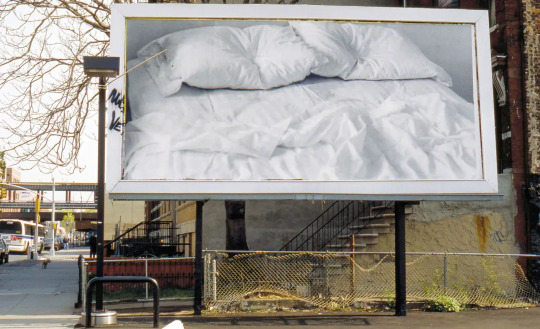
Felix Gonzalez-Torres - Untitled (billboard of an empty bed), 1991
These billboards were exhibited in the streets of Manhattan during the AIDS crisis. This piece was created the same year Felix Gonzalez-Torres's boyfriend Ross died. This portrait is a celebration of love and a memorization of loss and the emotions between intimacy and publicity. In the artist's own words:
“What I’m trying to say is that we cannot give the powers that be what they want, what they are expecting from us. Some homophobic senator is going to have a very hard time trying to explain to his constituency that my work is homoerotic or pornographic, but if I were to do a performance with HIV blood — that’s what he wants, that’s what the rags expect because they can sensationalize that, and that’s what’s disappointing. Some of the work I make is more effective because it’s more dangerous. We both make work that looks like something else but it’s not that. We’re infiltrating that look.“
The work intentionally uses the matching, identical depressions to imply a same-sex couple. The image itself is extremely intimate, but its being displayed in public spaces.
Felix Gonzales-Torres became known for his absent bodies.
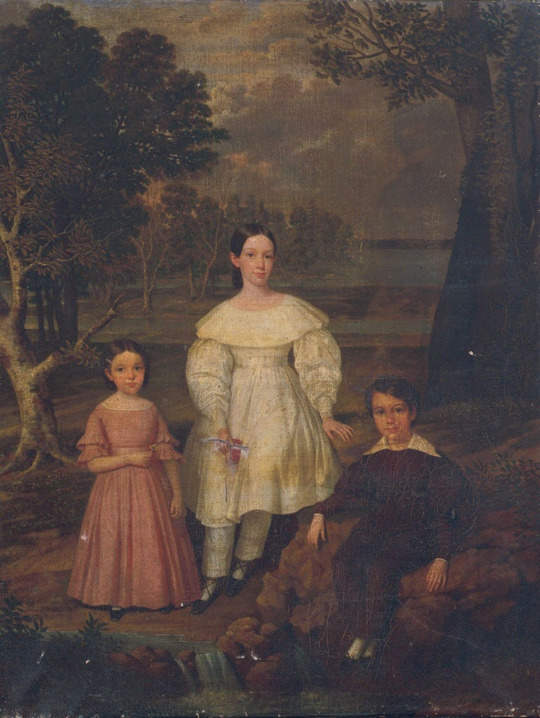
And then, a little different, this painting by Jacques Guillaume Lucien Amans (1837) commissioned by Frederick and and Coralie Frey, depicts the three Frey children, with the faint shadow of a figure. There was a legend that there was a fourth figure in this painting. In 2005 a private collector, Jeremy K Simien, purchased the painting and it underwent conservation.
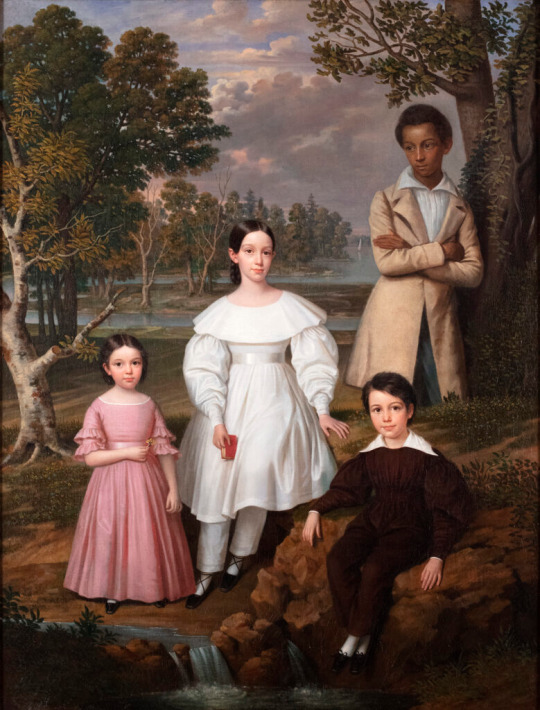
The painting revealed Bélizaire, a fifteen year-old enslaved domestic owned by the children's father. The picture captures the complex relationship between the boy and the children, the family that was keeping him captive. For one thing, the way he is set back from the others. There is this sort of intimacy between them along side the psychological trauma of forced bondage.
Here is a great Tiktok about the painting, to quote "What I'm struck by is what a sensitive portrait this is of this young man who was living in an inhumane society where he, despite being a human being, was bought and sold."
A few years after this painting was created, the three Frey children died, and Bélizaire was the only one who survived into adulthood.
The painting stayed in the Frey family. At some point, likely in the late 19th or 20th century, Bélizaire was intentionally painted over. In 1972, the great-granddaughter of Coralie Frey donated the painting to a Louisiana museum, informing them that a figure was painted over. During the course of the painting's life at the museum, no effort was put into restoring the figure.
Jeremy Simien's, who bought and restored this painting, said on his instagram "Bélizaire, they know your name now. Tell the ancestors to let me sleep for a minute."
And shout out to the picture that make me want to write this, Hyde Park Flowers, London by Tumblr user @kimironside I won't re-post it so check out the link.
#art#art history#felix gonzalez torres#belizaire#david hockney#Jacques Guillaume Lucien Amans#Jacques Amans#Jeremy K Simien#tw slavery#tw aids
1K notes
·
View notes
Text
Casual reminder that this scene in Good Omens
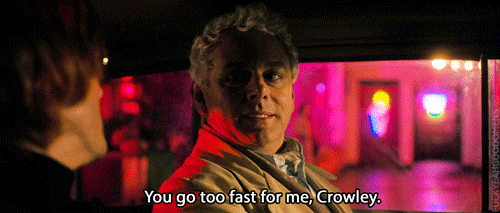
(The “I’ll give you a lift, anywhere you want to go” scene, the “you go too fast for me, Crowley,” scene)
Takes place in 1967.
The same year that “homosexual acts” between men were decriminalized (to a certain extent) in England and Wales.
The Sexual Offenses Act of 1967 decriminalized sexual activity in private between consenting men over the age of 21.
This law wasn’t a cure-all, obviously. It still wasn’t safe for gay men to show most forms of affection in public; you could still be charged with gross indecency, the penalties for which could be dire. (Prior to this law, even private, consensual relations could be prosecuted; Alan Turing was charged with gross indecency in 1952, and his subsequent trial, conviction, and chemical castration is considered to be a major factor that led to his suicide in 1954.)
In addition, the age of consent for heterosexual and lesbian couples was 16, in contrast to 21 for gay men. Many attempts to equalize this disparity failed in Parliament until 2000, when the Sexual Offenses Act was amended.
So, the passing of the Sexual Offenses Act “wasn’t a moment of sudden liberation for gay men,” as Florence Sutcliffe-Braithwaite wrote in BBC History. But it was one of the major milestones for LGBTQIA+ rights in the UK. It was a necessary prerequisite for the increase in LGBTQIA+ rights activism that happened there in the 1970s.
For audiences not from the UK (and indeed, to many *from* the UK) much of this historical context will likely be missed by viewers when watching this flashback scene. I’m American and definitely lacked most of this context the first time I watched the show. A viewer may recognize that the backdrop of late-night Soho in the late 1960s represented a very specific cross-section of British society that was considered by much of the general public to be “distasteful” and subversive (to put it VERY mildly) at the time. But that’s just the broad strokes.
Having additional historical details, beyond the broad strokes, goes a long way to deepen our understanding of the cultural landscape that Aziraphale and Crowley would have observed and experienced as residents of London during that period. That secretive rendezvous in the Bentley was not only risky in the sense that they might attract the attention of Heaven or Hell; they also risked being seen by a human, possibly a police officer. To a human, it would have looked like two gay men meeting in public, at night, in an “unsavory” part of London, and could have drawn all sorts of negative attention to the two of them.
The truth is, Aziraphale and Crowley are categorically not gay nor are they men. But they are unquestionably queer and theirs is undeniably a story of queer love. And each time they meet up throughout history, and by necessity must do it clandestinely, the historical context points this queerness out to the audience. It’s queerness the way bell hooks once put it: “‘queer’ not as being about who you’re having sex with (that can be a dimension of it); but ‘queer’ as being about the self that is at odds with everything around it and that has to invent and create and find a place to speak and to thrive and to live.”
In the present day (which will in large part be the time-setting for Season 2), the current social climate for the LGBTQIA+ community is becoming progressively more terrifying.
As recently as 2015, the UK was considered the best out of 49 European countries for LGBTQIA+ rights by the International Lesbian, Gay, Bisexual, Trans and Intersex Association Europe (ILGA - Europe). Eight years later, the UK’s 2023 ranking on the same index has dropped significantly to 17th place, mostly due to the growing anti-trans rhetoric in public life. Transphobic hate crimes have grown by 56% in England and Wales since ILGA’s 2022 report. Homophobic hate crimes have also increased sharply, up by 41% since 2022.
Meanwhile, in the US, 2023 marks the fourth record-breaking year for anti-trans legislation. So far this year, 562 anti-trans bills have been proposed, 79 of which have been signed into law, and 354 are in active debate in their respective legislatures. In Florida, a bill recently passed that criminalizes gender-affirming healthcare for children and allows the state to take children from their families if they suspect the child is receiving such care. This is not limited to hormone replacement therapy - it also includes gender-affirming talk therapy. Florida has some of the most egregious examples of such legislation, but many states - Texas, Tennessee, Alabama, Indiana, and many others - have certainly been pursuing the same path. The number of sanctuary states is dwindling, and many families in trans-hostile states lack the resources they’d need to move somewhere safer, meaning these families live in a state of constant fear. (“LEAVE TRANS KIDS ALONE, YOU ABSOLUTE FREAKS.”)
So as we get every day closer to Season 2: always bear in mind the context. Remember the past. Be aware in the present. Consider the future and do whatever work that’s within your power to make it a good one.
#good omens#good omens 2#good omens meta#history#lqbtqia#queer#queer history#transphobia tw#homophobia tw#mention of suicide
76 notes
·
View notes
Text
Utopia K67
In his novel Blindness Jose Saramago narrate a story of a plague that affects the city so the encounters between inhabitants become increasingly frightening. The immense absurdity of the capital development of the contemporary city recalls Saramago's apocalyptic vision of the development affected by an epidemic of white blindness.

How will we live together when public spaces are sold out? The story is a parable of the fear of the unknown - is it war, isolation or just the fear of being to close to each other?
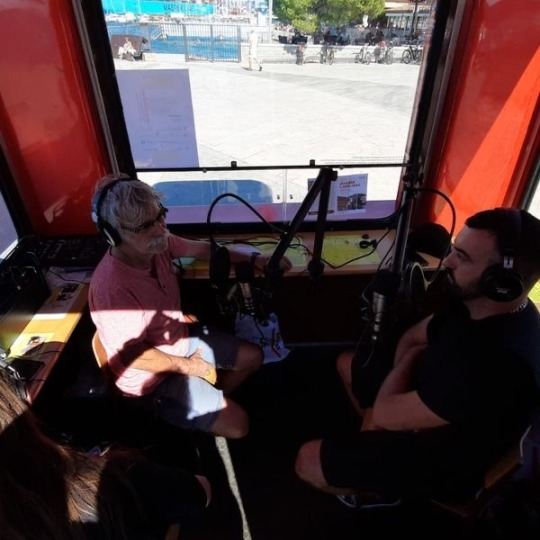

Public talks in K67 with local cultural and political figures transmitted live on-air of Independent Coastal Radio NOR.
The utopia starts in projects that are going beyond the expected rules. It points out the neuralgic problems of the location and seeks the analysis of the current state of matter. One of the utopias stands in a small Slovenian coastal town Koper - in a public square where a parking lot is situated on the most prominent position next to the sea.

The utopia - K67 kiosk, designed by Saša Mächtig in 1967, concludes its story with the absurdity of the use of the public square next to the sea in favor of parking. As the writer and journalist Martin Reichert, to whom we dedicated this project, would say, “it is a parking lot with the most beautiful view in the world."

K67 is one of the best examples of design during the former Yugoslavia. In the context of the presentation in the public space, with the help of the owner Coastal Galleries Piran, it was placed on the square in Koper in December 2021, in order to become a new generator for its urban content.


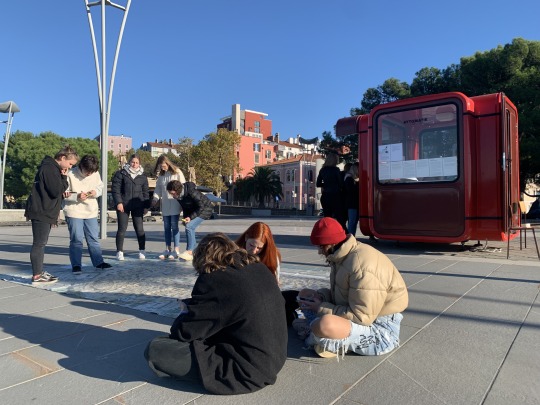
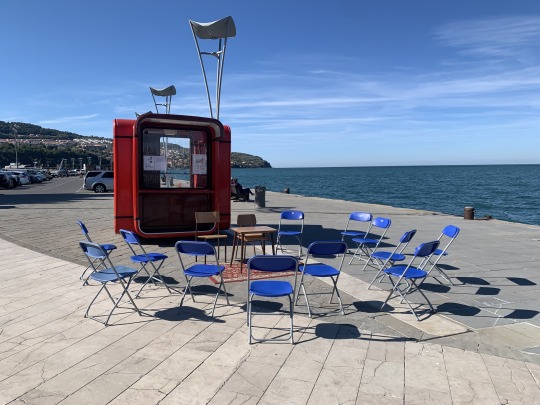






youtube
From spring to late autumn 2023, a process of tactical and performative urbanism took part in the K67 in favour to create an inclusive public space. The main concept proposed and elaborated within the municipality was based on the change of the current parking lot on the square into a green community space.

Unfinished project Solis was more than ten years a failure of a PPP concept. After COVID the investor succeeded to add two more floors of the private apartments.
Tactical urbanism is the opposite of investment urbanism, which has a dispersed structure of activity in space and builds various, mainly residential buildings that sell well, but without a well-thought-out placement in the context of the city. The last plan for Koper was signed by the architect Edo Mihevc in the 1960s.

Urban Plan for Koper, Edo Mihevc (1961). | Source © Neža Čebron Lipovec

The renovation of the new roof for the city market was executed via the municipality but without a public competition.
Today it looks like investor urbanism is much faster than the concept of town planning per se. This results in a fact that there is no more urban planning in the city of Koper today.



The farm market with live animals in plastic tent on Ukmarjev square shows the discrepancy of communication between the municipality and experts.
In Koper as in other towns across the Adriatic coast there is an obvious pressure from investor urbanism. Public spaces are mostly touristized, privatized and don’t belong to dwellers anymore. Therefore is important to ensure that buildings are not built without public competitions. The K67 stays a reminder of a utopia that shall make aware of the importance of reuse and creation of community spaces.
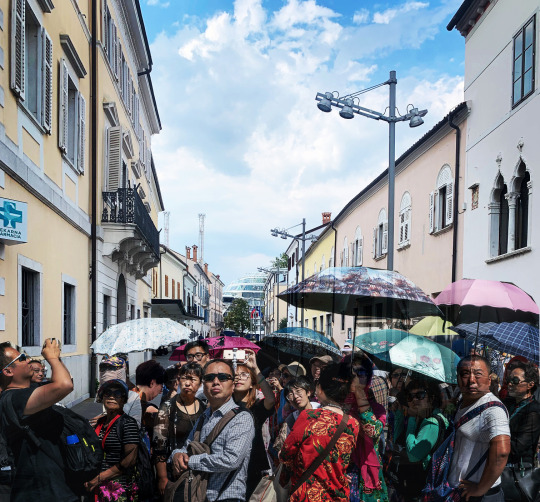
The cruise ships don't need to pay tax in Koper so instead of Venice, were are banned are welcomed for a pollution of cruise tourism.

The utopia K67 is dedicated to the writer and journalist Martin Reichert.
28 notes
·
View notes
Text

Today We Honor Emory Douglas
Born in 1943 in Grand Rapids, Michigan, Emory Douglas has been a resident of the Bay Area since 1951. He became the Minister of Culture for the Black Panther Party in 1967, a role he held until the party disbanded in the early 1980s. During the Party’s active years he served as the art director overseeing the design and layout of the Black Panther, the Party’s weekly newspaper. Douglas was trained as a commercial artist at City College of San Francisco and has been the subject of several solo exhibitions.
His work has also been in numerous exhibitions about the history of the Black Panther Party, including shows at the Arts & Culture Conference of the Black Panther Party in Atlanta, GA in 2008 and “The Black Panther Rank and File” at the Yerba Buena Center for the Arts, San Francisco in 2006. Most recently his work was the subject of a solo exhibition at Urbis, Manchester, UK in 2008-2009.
In 2007, artist Sam Durant curated a solo exhibition of Douglas’ work at the MOCA Pacific Design Center in Los Angeles, “Black Panther: The Revolutionary Art of Emory Douglas,” which is the inspiration for the presentation at the New Museum.
The same year, Rizzoli published a book with the same title that included essays and interviews about Douglas’s work and his relationship to the Black Panther Party. Douglas’s work has also been presented at the 2008 Biennale of Sydney, Australia; the African American Art & Cultural Complex, San Francisco; Richmond Art Center, CA; and the Station Museum of Contemporary Art, Houston. via gclass.org | CARTER™️ Magazine carter-mag.com #wherehistoryandhiphopmeet #historyandhiphop365 #carter #cartermagazine #emorydouglas #blackpanther #blackpantherparty #blackhistorymonth #blackhistory #history #staywoke
#carter magazine#carter#historyandhiphop365#wherehistoryandhiphopmeet#history#cartermagazine#today in history#staywoke#blackhistory#blackhistorymonth
47 notes
·
View notes
Text
The images of woman as object, not as active agent or creative autonomous subject, ensure that women remain on the outside, that women's voices are not heard. As history describes the doings of men, as fine art is the art created by men, as literature is writing produced by men, and as classical music is that composed by men, so the science, the news, the art, the literature, the music of today is that produced by men. The patriarchs are adamant that this should be so. The conductor, Sir Thomas Beecham, pronounced, “There are no women composers, never have been, and never will be.” John Ruskin confidently declared “No woman can paint.” And Swinburne claimed that, “When it comes to science we find women are simply nowhere. The feminine mind is quite unscientific.” Virginia Woolf's ponderings on the (im)possibility of ‘Shakespeare's sister’ who might have wanted to write, characterize the position of women in the creative sphere. As Tillie Olsen illustrates, in her now classic text, Silences, woman's voice has been absent from the world's creative arena for centuries. Unfortunately, it seems as if it still is.
But why are women so silent in the scientific, professional or creative spheres of life? The traditional reductionist argument, rehearsed earlier, is that women are somehow unable to think, to paint, or to write because of affinity with nature and lack of intellect. Or is it rather that we are not allowed to, through the systematic exclusion of women's work in the public sphere, or through the maintenance of women's work in the home the maintaining of women as servers, as the 'angel in the house', rather than as active creators of artistic discourse? Is it that women are producing creative material, but it is being systematically ignored? For there are many who profit from the reification of the male creator and the simultaneous reduction of women's creativity to the sphere of childbirth, as this extract from a misogynistic male critic illustrates:
A few years back I read a neo-feminist's approving review of another neo-feminist's book. The reviewer said that she agreed with the author that for a woman, a career is more creative than being a mother. That puzzled me: without having given much thought to it, I had assumed that about the closest the human race can get to creation is when a woman bears a child, nurtures him, and cares for him [sic]. (Himmelfarb, 1967: 59; my emphasis)
If women can believe that childbirth is unsurpassable as a creative act, perhaps they will put down their pens and their paints, cease thinking and continue breeding. Is it a coincidence that the male pronoun is used to refer to the product of female creativity? Is it as creative to produce a female child? Or is this yet another comment produced without having given much thought to it?
The reason for women's absence on the world stage of creativity is not biological inferiority, nor an absence of desire to create beyond the realms of the family. The real reasons for the silence are not very difficult to discern; nor are the effects. Take the case of art, as many feminist scholars recently have, rewriting the history of art through a feminist prism. Our Old Masters and masterpieces - the art which fetches astronomical prices, elevating the artist to an almost godlike status, his creativity seen to be drawn from some higher power - are all the work of men. The history of art is peopled with men, not women. The male artist is the hero; the female artist is invisible. The woman is present only as the object of the artist's gaze, to be consumed, to be frozen and framed, to be possessed. Feminist analysis has identified the way in which women's voices and women as active agents have been suppressed; the way in which women are destined 'to be spoken' (in Lacanian terms) rather than to speak. It is the same process that silences talent, as recent texts on the 'forgotten' women artists, scientists, or authors has shown. It is produced by a systematic suppression - a systematic oppression - achieved by promoting and validating the work of men whilst ignoring, or denying the existence of, the work of women.
Whilst women writers from Aphra Behn to Mary Wollstonecraft have been rediscovered by feminist literary scholars and feminist publishers, many others have not. Many women never had the time or opportunity to publish - and their voices will never be heard. Many women remain silent, following in the painful footsteps of our foremothers who never have the time or legitimacy for reflection and creation. It is moving to consider how many brilliant voices have not been heard, how many brilliant careers have been thwarted. As Olive Schreiner reflected:
What has humanity not lost by suppression and subjection? We have a Shakespeare; but what of the possible Shakespeares we might have had who passed their life from youth upward brewing currant wine and making pastries for fat country squires to eat, with no glimpse of freedom of the life and action necessary even to poach on deer in the green forests; stifled out without one line written, simply because of being the weaker sex, life gave no room for action and grasp on life?
In addition to marginalizing women, and ensuring that we cannot find a voice with which to declare our anger, our desperation, or our fears, the images can be seen to have a more invidious function in that they objectify women. They ensure that we have few role models to turn to for inspiration. We expect to be confined and constricted. We expect to serve men. Is it any wonder that we despair, that we cry out, that we are mad? And if the woman herself was not treated as mad for daring to be creative, she may have been driven so by the restrictions upon her. It is an insidious double bind: women who do attempt to create may be vilified for their talent, and for their temerity in daring to speak out. Whether a woman's creativity is an expression of inner conflict and turmoil, or merely a desire for self-expression, it is in danger of becoming the tool which condemns, a centuries-old process, as Virginia Woolf eloquently shows:
.. any woman born with a great gift in the sixteenth century would certainly have gone crazed, shot herself, or ended her days in some lonely cottage outside the village, half witch, half wizard, feared and mocked at. For it needs little skill in psychology to be sure that a highly gifted girl who had tried to use her gift for poetry would have been so thwarted and hindered by other people, so tortured and pulled asunder by her own contrary instincts, that she must have lost her health and sanity to a certainty. (Woolf, 1928: 48)
The feminist martyrs, diagnosed as mad, 'treated' by patriarchal experts, and (often) destroyed by their own hands, have fuelled arguments that madness is protest, an expression of thwarted creativity. And within a culture which refuses to recognize women's creativity (except in the area of motherhood) it is argued that its frustration leads to madness. Phyllis Chesler opens her book, Women and madness, with a testimonial to four such women, Elizabeth Packard, Ellen West, Zelda Fitzgerald and Sylvia Plath. In her description of their madness as 'an expression of female powerlessness and an unsuccessful attempt to reject and overcome this state', Chesler argues that the experiences of these women symbolize the oppression of women's power, women's creativity - an oppression with fatal consequences (Chesler, 1972: 16). Her argument - that the inability of these women to express themselves, their silencing by men, has led to their madness and their suicide - has obviously struck a chord in the hearts and minds of many women. Their icons and heroines are women like Sylvia Plath, women seen as victims of the individual men who thwarted their intellect, as well as victims of a society which sees women, not as active subjects, but as objects. When we read Plath's words, ‘Dying/Is an art, like everything else./I do it exceptionally well,’ a chill hand clutches the heart: although many would like to emulate her creativity, they fear the fate that befell her. We must, however, be careful not to glorify these women, raising them to the status of martyrs, for, as Tillie Olsen demonstrates, suicide is rare among creative women. What is undoubtedly more common is the slow creeping frustration, the inability to think, to breathe, to work at anything other than the daily grind. For women's creativity is not frustrated only by the structural barriers provided by the male-dominated academies and universities, and the male publishing houses, but also by the lack of time. For if male writers such as Hardy, Gerard Manley Hopkins and Joseph Conrad can share this experience described by Conrad, how must it be for the woman whose main task is the care of her children, her husband, her home?
I sit down religiously each morning, I sit down for eight hours, and the sitting down is all. In the course of that working day of eight hours I write three sentences which I erase before leaving the table in despair.
It is no coincidence that 'in our century as in the last, until very recently, all distinguished achievement has come from childless women' (Olsen, 1978: 31). How many women can find time to await the visit of the muse in moments snatched between children and housework? It is a wonder that Jane Austen managed to write - hiding her papers under a blotter in her parsonage drawing room - by snatching a few lines, a few thoughts, when the scarce moments of solitude were upon her. How many others must have given up, despairing, angry and defeated?
Even those women who manage to ward off the angel in the house, and can find a room of their own, may be remembered chiefly for aspects of their personal lives, their work forgotten, and their creativity reduced to voyeuristic intrusions on their sexuality. As French says:
Whether a woman had a sex life, what sort of sex life it was, whether she married, whether she was a good wife or a good mother, are questions that often dominate critical assessment of female artists, writers and thinkers. (French, 1985: 97)
The critics who pore over men's work with an academic glee, hardly noticing their personal lives, seem unnaturally interested in the woman creator's personal habits and especially in her sexuality. This allows the creative woman to be presented as unbalanced, unnatural, and certainly not representative of women. Thus, 'Harriet Martineau is portrayed as a crank, Christabel Pankhurst as a prude, Aphra Behn as a whore, Mary Wollstonecraft as promiscuous' (Spender, 1982: 31). Sylvia Plath, one of the foremost creative women of the late twentieth century, has been similarly treated. Biographers, commentators and critics seem more interested in her adolescent sexuality, her relationships with men during her college years, and her marriage, than with her work.
That a woman who produced brilliant poetry could also be sexual is seen to be a peculiarity. That she killed herself allows her to be seen as mad, and thus as not a normal woman. This over-concern with her sexuality and sanity detracts from her work, and is an insult to this gifted poet, and to others who might follow her. The message to women is clear - dabble with the muse, attempt to enter the male world of learning, of thinking, of creativity, and you may pay the highest price.
-Jane Ussher, Women’s Madness: Misogyny or Mental Illness?
#jane ussher#female artists#female mental health#female oppression#female erasure#female creativity#female voice
51 notes
·
View notes
Text
Fest for Beatles Fans 2024 Write-Up
In case anyone wants to know what goes on at these things, I can at least give you a run-down of what I did at this one, though as always there was far more going down than any one person could see. I tend to favor panels and discussions over bands, so I am sure I missed a lot of great music. Because the bands were great.
It was held this year at the TWA Hotel, which is part of JFK International Airport and has retained a lot of the features of when it used to be a terminal. I posted photos of it last year when I was there on a layover, and I still love it to death. They did NOT let me ride on the baggage thingy though. In addition, I was unable to secure a room at the hotel, though if they hold it here again I will be snagging one because, like I said, the place is bonkers.
Friday
I entered my cross-stitch in the art contest, because why not? While there ran into several people whom I had met last August at the Fest in Chicago.
Beatles Biography panel with Vivek Tiwary (The Fifth Beatle graphic novel) and Madeline Bocaro (In Your Mind - The Infinite Universe of Yoko Ono). Vivek comes off very passionate and sweet, very respectful of Brian Epstein and cognizant of the importance of telling his story right. Bocaro is also very passionate, but I'm afraid some of us present her personal Ono pendulum has swung too far to admit any human fault in her subject. I later bought the Brian book, but not the Ono.
First Generation Fan Panel was mostly Leslie Healy recounting her adventures, which are legion: she was at the Ed Sullivan dress rehearsal, and at Shea Stadium, and she's *also* the one who got that audio at Paul's house when she visited all four Beatles in 1967. Also, she had a Bearded Collie, which I also had growing up, so that gave me a thrill.
I entered the 60s dress up contest -- second time as Twiggy was the charm, and I won! And then there was a lot of dancing. Gogo boots, ironically, not so much made for such activities.
Saturday
Chatted with some folks because it was more interesting that listening to the speakers, oops. The guy from the Ranking the Beatles podcast is lovely and we've already been in touch since. Also Terry Crain who wrote a great coffee table book about NEMS Beatles merch, which I bought last year.
Went to the dealer's room and bought silly buttons, like TO HELL WITH THE 'BEATLES' and I ❤️ PAUL. There were butcher covers and all that jazz, and horrid dolls, and all the lovely awful things, none of which I could ever afford. But I can buy buttons!
Lovely friends entered the talent contest and proceeded to the finals, and they kicked so much ass and I am so proud of them.
Academic panel with Ken Womack, Christine Feldmman-Barrett, and Andy Nichols was pretty good, a lot of talk about how subsequent generations get hooked and sort of the state of Beatles fandom/academia today. Which feels fairly positive, in the sense that all present felt there is more respect now than there was--though still room to improve on that score.
As a side note, all of my interactions with Womack convince me he's a great guy, very passionate in his love for the Beatles and very devoted not only to doing this right but in elevating lesser-heard voices. He's a very likable man.
Speaking of, next he interviewed Laurie Kaye, who did the radio interview with John on his last day. Her story was very moving.
Tried to dance again this evening after the talent show but unlike the previous night, everyone thought we were weird and stared forbiddingly at us from their seated positions.
But my PAUL IS DEAD / IF YOU WANT IT / HAPPY CHRISTMAS FROM JOHN & YOKO shirt was a hit. Finally.
Sunday
Saw Jude Southerland-Kessler talk about the "birth of the beatles" but sadly it was NOT about the tv film of the same name. So I went to chat with Adrian Sinclair and Allen Kozinn instead, which they later tweeted about.
Beatlemania in the 21st Century panel was about, well, what it says. Next was Women's History of the Beatles which was also interesting and involved various writers, teachers, fans, podcasters, etc. I got to meet Erika from BC the Beatles which was very cool.
Then came the Laurence Juber and Steve Holley panel which I have mentioned elsewhere.
Jenny Boyd talked about fashion and the Apple Boutique, hosted by a lady who wrote a book about Beatles and fashion I would like to read.
Fantastic band with great additional harmonies, which I knew who they were.
I did not win the art contest. I did get a participation ribbon. I'm not even a millennial.
We then found a quiet place to chat, of which which the hotel had many, and then I needed to go to bed so I could be bad in like five hours for my flight.
I've probably forgotten lots of things but that is the general run down. There was also a video room, two stages for bands, more art, authors and guests at tables all weekend, and Mickey Dolenz, whom I did not meet but it's cool he was there.
#yes i know some of you were there too i'm just not outing you#kris talks a lot#beatlesfest2024#fest for beatles fans
7 notes
·
View notes
Photo

Forgotten concerts: Leonard Nimoy sings at Riverside Park in Agawam on April 23, 1967
"Star Trek" actor Leonard Nimoy performs at Riverside Park in Agawam on April 23, 1967.
(The Republican)
The late Leonard Nimoy made several visits to Western Massachusetts as an acclaimed photographer, but the Boston-born actor also sang in concert at Agawam's Riverside Park.
It was during the first season of NBC's "Star Trek" that Nimoy took to the amusement park stage twice on April 23, 1967 to sing tunes and read poetry from his forthcoming DOT record album "Leonard Nimoy Presents Mr. Spock's Music From Outer Space."
The album featured such songs such as "Where Is Love" from "Oliver," "You Are Not Alone" and the anti-war tinged "Visit to a Sad Planet."
"I am not actively involved in any peace movements or organizations," Nimoy told The Springfield Union during his visit, "but I strongly believe in peace."
He mixed music and poetry with storytelling and an audience question and answer session during his afternoon and evening performances. He said singing was his first departure from acting and he found it "exciting and very immediate."
Nimoy revealed he had no interest in astronomy, did not believe UFOs were from outer space and that Ray Bradbury was a favorite sci-fi author "because he only uses the environment to tell stories about people, and I am interested in people."
The 36-year-old Nimoy drew an excited crowd of more than 1,000 for there afternoon snow and Agawam police had to clear a path from autograph seekers.
He returned on Aug. 13, 1967 for three additional performances at Riverside.
Nimoy was not the only "Star Trek" cast member to appear at the Agawam amusement park during the show's run.
Nichelle Nichols, who played Lt. Uhura, performed at Riverside on April 21, 1968. (Source: https://www.masslive.com)
55 notes
·
View notes
Text
[ GET TO KNOW … MAMIKO ! ]
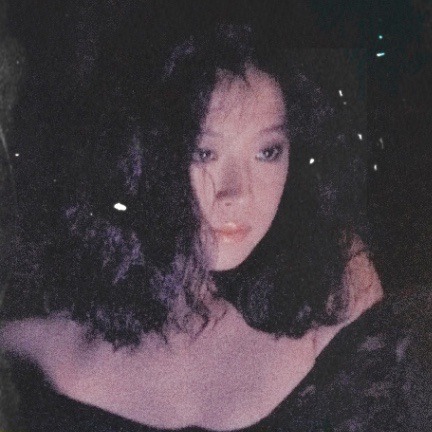


[ BASICS ! ]
BIRTH NAME ! nakamura mamiko
ENGLISH NAME ! michelle sandra takahashi
NICKNAMES ! miko, mimi, shelly
BIRTHDAY ! april 19th, 1967
ZODIAC ! aries
BIRTHPLACE ! nakagawa, nagano, japan
HOMETOWN ! aoyama, tokyo, japan / yanaka, tokyo, japan / new york city, new york
ETHNICITY ! japanese
NATIONALITY ! japanese-american
SEXUALITY ! straight
[ PHYSICAL ! ]
HEIGHT ! 5’5” 1/2 (166 cm)
WEIGHT ! 115 lbs (52 kg)
BLOOD TYPE ! A
PIERCINGS ! none
TATTOOS ! none
[ CLAIMS ! ]
FACE CLAIM ! akina nakamori (soloist)
VOICE CLAIM ! hiromi iwasaki or junko ohashi (soloists / japanese), sophie ellis-bextor (soloist / english)
[ CAREER ! ]
COMPANY ! pony canyon (1985–1991) / victor entertainment (2014–present)
OCCUPATION ! idol, songwriter, actress, television personality, businesswoman, former model, magazine editor, former hostess, socialite
DEBUT DATE ! december 1st, 1982
TRAINEE YEARS ! none
YEARS ACTIVE ! 1982–1991 / 2014–present
FANDOM NAME ! mamicchins
[ BACKGROUND ! ]
NAKAMURA MAMIKO was born on april 19th, 1967 in nakagawa, nagano, japan to NAKAMURA FUMITO and INOUE AKINA. the former owned a small rice farm on the family’s property, while the latter was a waitress turned stay at home mother and seamstress. the nakamura family lived in the countryside of japan in a densely populated area, and due to their parents’ meager jobs, they lived at the poverty line. MAMIKO was the fourth child out of seven, and as she grew, she would have to assist her mother in taking care of her younger siblings or help her father on his farm.
as a child, MAMIKO always had an affinity for music, as she would sing to artists such as MOMOE YAMAGUCHI and DIANA ROSS even as a toddler. despite her interest and participation in her school’s choir, she didn’t make much effort to go into the entertainment industry, as resources weren’t readily available in her small town. in fact, MAMIKO initially wanted to become a neurologist. at the age of 13, she was spotted on the streets of nagoya by a modeling agent, but her parents declined as they wanted her to focus on her studies.
due to nakagawa lacking a high school, MAMIKO and her siblings were forced to attend one in nearby nagoya, which was over thirty minutes away. during her second year, she met FUJITA CHIYAKO, and the two shared a similar passion for music. over the next year, their parents would grow close. chiyako’s father, FUJITA MASASHI, was the president of a moderately large recording company, and wanting to support his daughter’s dream of entering the idol industry (and having knowledge of MAMIKO’s similar aspirations), he put together an idol duo consisting of both girls. called MAMICHI, a combination of their names, the duo debuted on december 1st, 1982 with the single “KŌKŌ NO KAIHŌ.” the single did moderately well, selling a little over 9,000 copies and peaking at number eighty-seven on the ORICON charts. their debut mini album sold even less, selling a mere 6,500 copies.
despite the lack of major success, MAMICHI pushed for as many magazine shoots and interviews as possible, even managing to land the cover of CANCAM with the help of chiyako’s father. they had only four television appearances during their entire career, two being performances on MUSIC FAIR, while one was an interview on a variety show, and another was a christmas special, where they were two of twenty singers who sang the closing song. and the girls didn’t get to sing as individuals. during their parts, they always had to sing together. even with MAMICHI’s determination, however, the duo only had two more “hit” singles and released one final extended play before breaking up for good.
the first was “KAERU NO BABY,” released on march 16th, 1983. the duo’s most successful single and the definition of a “sleeper hit,” the song debuted at number ninety on the ORICON charts before shooting to number sixteen two weeks later. it sold a mere 5,500 copies within its first week, but by the third, it had sold over 20,000. although not a huge success, it was more than enough for MAMIKO and chiyako. the two had their first major performance at a music festival in may, and shortly before, they released their debut solo singles. MAMIKO’s was “WATASHI NO KOKORO NI MUKATTE,” a song in which she helped in the writing of. however, it paled in comparison to chiyako’s single, selling only 2,000 copies and charting at number ninety-six on the ORICON charts; the lowest selling and lowest charting of any singles to come out of MAMICHI. it was vastly overshadowed by chiyako, who had a bubbly, stereotypically “idol” like sound comparable to SEIKO MATSUDA, which was popular with the public at the time. MAMIKO’s own single was only moderately popular for its difficult high note, but even then, that didn’t boost sales, and chiyako still gained more popularity than her.
in september, MAMICHI would release their final single, “YŪGURE NO MONOGATARI.” it was less of a success than their previous single, selling a little over 10,000 copies and charting at number twenty-six. although another EP (which was meant to be named JE T’AIME; someone bought photos of what was supposed to be possible album covers at an auction, and demos of some tracks were leaked to 2CHAN in 2005) was planned for release shortly after, it would never come to fruition. in october, the girls would hold a press conference, with chiyako explaining that she wanted to return to school. their manager would explain that a solo debut for MAMIKO was being discussed, but that, too, would never happen.
due to her lack of popularity, MAMIKO decided that it wouldn’t be in her best interest to begin a serious solo career, and she ended up returning to school, as well. in late 1983, she began modeling at the request of one of her classmates, and subsequently appeared on the covers of magazines such as SISTER, JJ, and even SEVENTEEN. her work as a model got her a few acting gigs in various dramas, all of which unfortunately went nowhere. and in between, MAMIKO would get a regular job at a bank in nagoya, be named first runner-up in that year’s MISS TEEN JAPAN pageant, appear in newspaper advertisements and a few billboards, and would take a school trip to germany.
however, in early 1984, MAMIKO decided to give her idol career one last shot. through a postcard application, she was chosen to compete on the talent show STAR TANJŌ. although she gained recognition through her cover of “THE BOSS” by diana ross, she ended up placing second. despite that, MAMIKO caught the attention of PONY CANYON, and was persuaded by the label to partake in auditions for upcoming idol group, ONYANKO CLUB. she made it through all five days, and on april 1st, 1985, she was introduced as the seventh member of the group. finally, after three years of failed attempts to get her music career off the ground, MAMIKO had made it into what would be one of japan’s highest selling idol groups.
despite ONYANKO’s popularity, MAMIKO herself would never garner a large fanbase of her own amongst the fifty-one other members. although she was rather beloved for her sweet vocals, beauty, and mature personality, her popularity paled in comparison to members such as ERI NITTA or YUKIKO IWAI. she became the leader and front vocalist of the group’s third subgroup, NYANNATSU, which debuted in september 1986. their debut did well (even managing to top the ORICON charts), and shortly after, in november, MAMIKO debuted solo for the second time, releasing “TELL ME” on the 14th. surprisingly, it sold decently, selling over 12,000 copies. however, the single only charted at number nineteen, and her debut EP—KINOSHITA—only sold a little over 9,000 copies. her single was one of the few ONYANKO CLUB singles to not top the charts, and it was the only one to not enter the top ten.
NYANNATSU would release three singles and three albums before ONYANKO’s disbandment in 1987, while MAMIKO would release two more singles and an album, all of which sold lower than its predecessors, although one single—“WATASHI NO PROMISE”—would be used as the ending for a rather popular anime. ONYANKO’s last single—“WEDDING DRESS”—was released in august, and it was the last single MAMIKO was a front vocalist for. following the group’s final concert on september 20th, they disbanded when she was twenty years old.
afterwards, MAMIKO managed to attend college in tokyo on a scholarship, but she was contacted again by PONY CANYON to begin a serious solo career. she accepted their offer, thinking that being a member of ONYANKO CLUB surely boosted her popularity by a bit. she would make her debut in january 1988 with “KOI WA SCANDAL,” and her debut album—RED LADY—would be released a month later. however, despite her hopes, her solo career saw little success. in fact, her acting career seemed to do far better. in late 1988, her first studio album, CATALOG, was released. the resulting single—“AMOUR SANS AMOUR”—did surprisingly well and was the second highest selling single of her career, selling over 13,000 copies and charting at number sixteen. her next single—“ASOBU NO EMOTION”—did slightly better, garnering MAMIKO her first (and, at that point, only) music award at the 1989 JAPAN RECORD AWARDS.
after selling out her first solo concert in the summer of 1989, MAMIKO’s career suddenly began to slow down, as the “golden age of idols” was coming to an end, and japan’s economic bubble was beginning to burst. she even began to struggle to find work as an actress, as she had to assist her family back in nakagawa, as they were severely affected by the economic crisis. in 1990, she tried her hand at an english debut with the album MEMOIR, but that became the biggest flop of her career, selling a measly 1,500 copies within its first week, and only managing to chart at number one hundred and ninety-one on the BILLBOARD 200 for a single week before falling off. in may 1991, MAMIKO released one final album in japan, a self-title, which sold 9,500 copies. and after a performance on MUSIC STATION, she would disappear from the entertainment world.
that same year, MAMIKO met tech heir TAKAHASHI HIDEHIKO, and they began dating in 1992. and another year later, they were married in a lavish ceremony in france. what MAMIKO failed to realize is that her husband’s family was rife with classism, and they strongly disliked that their eldest son was marrying a woman from a poor family. hidehiko’s parents frequently snubbed her, making passive aggressive comments and practically dedicating their lives to making her uncomfortable. they disliked that MAMIKO was using the family’s wealth to assist her family, and they hated that two years later, she gave birth to their second grandchild, KAORI.
hidehiko’s parents refused to accept kaori as one of their own, and they refused to see her, forbidding their other children to see her, as well. they would spend the next two decades falsely painting kaori as “illegitimate” and trying to question the validity of MAMIKO’s marriage to their son, which understandably pissed hidehiko off. and by 1997, he had mostly cut contact with his parents and the rest of his family. for the next six years, the family of three lived comfortably in tokyo, with MAMIKO falling into her role as a socialite, sporadically appearing in the media when she attended another social function. she even chose to participate in ONYANKO’s reunion in 2002, being one of the front vocalists for their comeback single, “SHŌMIKIGEN.”
however, in 2003, the takahashi family forced their way back into MAMIKO and hidehiko’s lives with a months-long and rather publicized court case that rocked the world. one the case was settled in late 2003, MAMIKO was forced to divorce her husband by his family, who had used their influence to convince the court that her marriage to hidehiko was invalid. she would end up getting custody of kaori, as the takahashi family was adamant on cutting contact between hidehiko and his daughter. losing her husband’s income forced MAMIKO and kaori out of their lavish neighborhood, and she was forced to take up two jobs to support both herself and her daughter. at some point, before moving to the united states in 2006, MAMIKO was forced to move the two of them to her parents’ home in nakagawa, as paying for their apartment in yanaka was cutting into her already meager income.
after moving to the states, she found a job as an editor for HARPER’S BAZAAR, and she and kaori moved into an apartment in new york city, where their living situation was a bit more comfortable. for the next six years, MAMIKO’s life would gradually begin to feel more normal. even as her daughter moved back to japan in 2011 to attend high school and begin her own career in entertainment, she would remain in the states, and wouldn’t return to japan until early 2013. that same year, she eased back into the music industry by writing songs for kaori, and would even pen songs for artists such as NAMIE AMURO and GIRLS’ GENERATION. that summer, she and hidehiko would even remarry after a decade of being apart in the same country where they had first wed twenty years prior, finally bringing their family of three back together. and in december, she collaborated with her daughter for a christmas single, and even before then, MAMIKO made a brief comeback to television by performing on KŌHAKU UTA GASSEN for the second time in 2011.
in 2014, public interest in her bygone idol career was piqued after a performance of “ASOBU NO EMOTION” (which happened to be her kōhaku performance) went viral on both NICO NICO DOUGA and YOUTUBE. as “thanks,” MAMIKO released a compilation album in september, and its subsequent success was the biggest surprise of the year. with over 500,000 copies sold across japan, it became the FIFTH highest selling album of the year, beating out namie amuro and NMB48. the album’s success shocked her, but she was unsure if she should return to the music industry, as she didn’t know if the success would last. however, MAMIKO was convinced to take advantage of her sudden popularity, and shortly after signing with VICTOR ENTERTAINMENT in early 2015, on may 16th, she released her first album in twenty-four years: PHANTASIA.
with sales of nearly a million copies, the album became the SECOND highest selling album in japan, placing just below her own daughter. it’s now MAMIKO’s highest selling album, and even after nine years, her popularity remains the same. she is now among japan’s highest selling and most critically acclaimed artists, and after nearly three decades of career setbacks, MAMIKO’s unexpected resurgence has garnered her the title of the “COMEBACK IDOL.”

#🍬 … MAMIKO !#PROFILE !#kpop oc#fictional idol community#kpop oc soloist#kpop solo artist#koc soloist#jpop oc#jpop oc soloist#jpop solo artist#jpop idol oc#jpop soloist#kpop soloist#kpop female soloist#fake idol#fake jpop idol#fake kpop idol#fictional idol soloist#fictional idol oc#koc
7 notes
·
View notes
Text
Yu Yu Hakusho Symphonic Collection I & II
Those two CDs are a selection of theme songs from "Yu Yu Hakusho", performed by the Nagoya Philharmonic Orchestra and conducted by Bob Sakuma.
Yu Yu Hakusho Symphonic Collection Vol. I (January/1995)
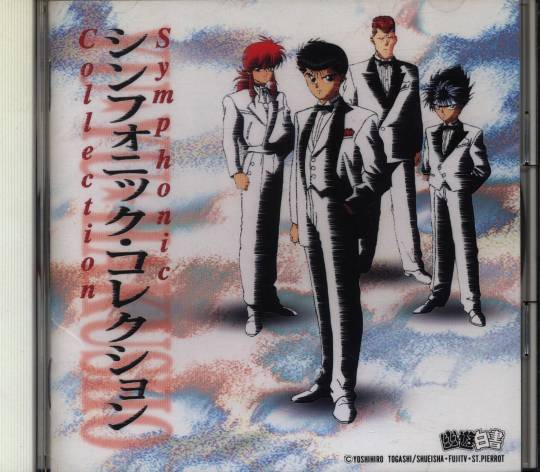

Cover

Booklet
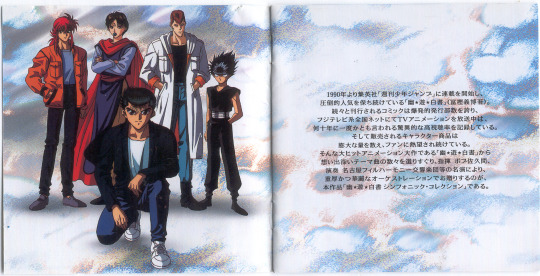
"Yu Yu Hakusho" (written by Yoshihiro Togashi) has been serialized in Shueisha's "Weekly Shounen Jump" since 1990 and continues to have an overwhelming popularity. The comic books have had a tremendous circulation, and the TV animation, which aired on nationwide Fuji Television network, has recorded an astonishingly high viewer rating, an event that is said to occur once in decades.
The amount of characters' goods sold is enormous, and they continue to be eagerly desired by the fans.
The "Yu Yu Hakusho Symphonic Collection" is a selection of profoundly memorable theme songs from the big hit and masterpiece anime "Yu Yu Hakusho". Conducted by Bob Sakuma with great performance of the Nagoya Philharmonic Orchestra, we will present you with a profound and magnificence orchestration.




Track List:

INTRODUCTION
2. Unbalance na Kiss wo Shite (アン��ランスなKissをして)
3. Hohoemi no Bakudan (微笑みの爆弾)
4. Kōri no Naifu wo Daite ~ Kokoro wo Tsunaide ~ Tasogare ni se wo Mukete (氷のナイフを抱いて~心をつないで~黄昏に背を向けて)
5. Taiyou ga Mata Kagayaku Toki (太陽がまた輝くと)
6. Homework ga Owaranai (ホームワークが終わらない)
7. Mienai Mirai e~Yasashisa wa Nemuranai~Hikari no Naka de (見えない未来へ~優しさは眠らない~光の中で)
8. Daydream Generation (デイドリーム・ジェネレーション)
9. Sayonara Bye Bye (さよならバイ・バイ)
10. END CREDITS


Bob Sakuma (ボブ佐久間)
Profile:

Composer, arranger, and conductor. At the age of 4, he started playing violin and piano, and at the age of 22, he made his debut as a composer.
Unsatisfied with the smooth sailing of the work as a writer, at the age of 27, he suddenly decided to emigrate to the United States, in order to know more about his own abilities on a global level. He lived in Hollywood, California, for 8 years, where he worked with many famous artists, especially in commercials and live performances.
In October 1985, he returned to Japan and settled there again. He has worked on numerous stages, TV shows, doramas, movies, musicals, etc., and his extensive composition (of music) activities have gained overwhelming support across genres such as pop, rock, jazz, and classical music.
Nagoya Philharmonic Orchestra (名古屋フィルハーモニー交響楽団)
Profile

Formed in 1966 by volunteer musicians of Nagoya City and surrounding areas, they gave their first subscription concert in October 1967.
Thereafter, they have steadily enhanced their skills while adjusting their structure as an orchestra. In 1988, they performed for the first time overseas, receiving great acclaim in various cities in Europe such as Paris and Geneva, and performing a great task as a cultural envoy.
T/N: Cultural envoy - figures and artists are sent overseas to engage in activities that will promote Japanese culture and create and reinforce cultural networks.
In recent years, symphonic pop concerts by symphony orchestras have become very popular, so they also have been very active in this area. In 1994, they have attracted attention from various circles with the "Symphonic Suite: The Silent Service," conducted by Bob Sakuma.
T/N: The Silent Service (沈黙の艦隊, Chinmoku no Kantai) is a manga series written and illustrated by Kaiji Kawaguchi.

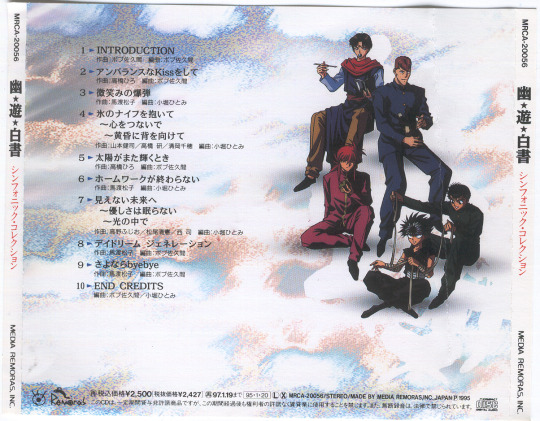

Yu Yu Hakusho Symphonic Collection Vol.II (June/1996)

Cover

Booklet
Track List:

1. INTRODUCTION "Makai no Ibuki" (「魔界の息吹」, "Breath of Makai")
2. Hohoemi no Bakudan (微笑みの爆弾)
3. Unbalance na Kiss wo Shite (アンバランスなkissをして)
4. Sayonara Bye Bye (さよならbyebye)
5. Daydream Generation (デイドリーム・ジェネレーション)
6. Taiyo ga Mata Kagayaku Toki (太陽がまた輝くと)
7. Homework ga Owaranai (ホームワークが終わらない)
8. Kurayami ni Akai Bara ~Romantic Soldier~ (暗闇に紅いバラ)
9. Dead or Alive ~Toushin~
10. Kuchibue ga Kikoeru (口笛が聴こえる)
11. WILD WIND ~Yasei no Kaze no you ni~
12. EYE TO EYE
13. Sayonara wa Mirai no Hajimari (サヨナラは未来のはじま)

All tracks are performed by Nagoya Philharmonic Orchestra, conducted by Bob Sakuma.
Profile
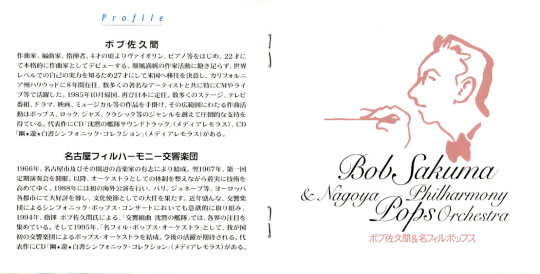
Bob Sakuma (ボブ佐久間)
Composer, arranger, and conductor. At the age of 4, he started playing violin and piano, and at the age of 22, he made his debut as a composer. Unsatisfied with the smooth sailing of the work of as a writer, at the age of 27, he suddenly decided to emigrate to the United States, in order to know more about his own abilities on a global level. He lived in Hollywood, California, for 8 years, where he worked with many famous artists, especially in commercials and live performances. In October 1985, he returned to Japan and settled there again. He has worked on numerous stages, TV shows, doramas, movies, musicals, etc., and his extensive composition (of music) activities have gained overwhelming support across genres such as pop, rock, jazz, and classical music. His representative works include the "The Silent Service Soundtrack" CD (Media Remoras) and the "Yu Yu Hakusho Symphonic Collection" CD (Media Remoras).
Nagoya Philharmonic Orchestra
Volunteer musicians from the City of Nagoya and the surrounding area founded the NPO in 1966. They gave their first subscription concert in October 1967. Thereafter, they have steadily enhanced their skills while adjusting their structure as an orchestra. In 1988, they performed for the first time overseas, receiving great acclaim in various cities in Europe such as Paris and Geneva, thus performing a great task as a cultural envoy. In recent years, symphonic pop concerts by symphony orchestras have become very popular, so they also have been very active in this area, attracting attention from various circles with the "Symphonic Suite: The Silent Service," conducted by Bob Sakuma, in 1994. Finally, in 1995, they formed Japan's first pop orchestra known as the "Mei-Phil Pop Orchestra". Their future success is greatly anticipated. One of their representative works is the "Yu Yu Hakusho Symphonic Collection" CD (Media Remoras).
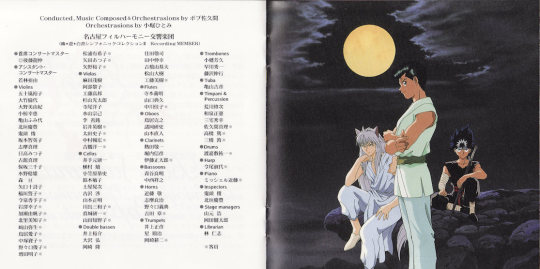
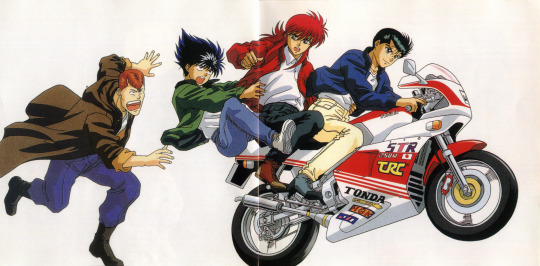

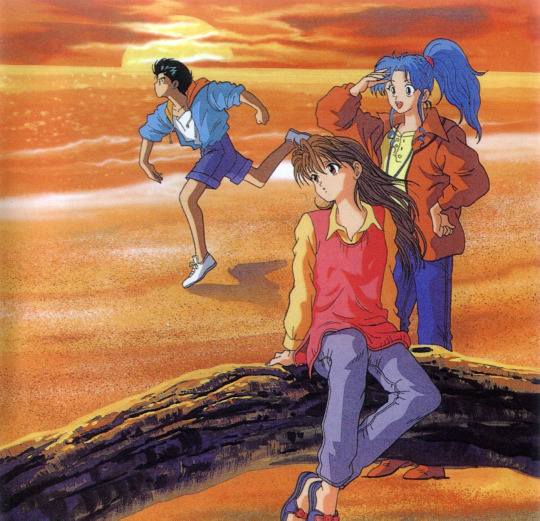

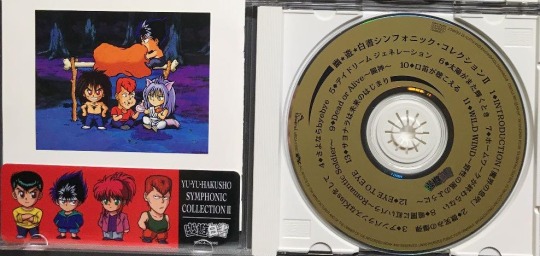
#Yu Yu Hakusho Symphonic Collection#Bob Sakuma#Nagoya Philharmonic Orchestra#media remoras#幽遊白書 シンフォニック・コレクション
73 notes
·
View notes
Text
Bands/Artists I Consider Personal Favorites (4/4)
With the three parts put together, the last piece of the puzzle is here.
------------
Tad
Origin: USA
Years Active: 1988 - 1999
Genre(s): Grunge // Alternative Metal // Noise Rock
Studio Albums: 4
Personal Favorite Album: Inhaler (1993).
Talking Heads
Origin: USA
Years Active: 1975 - 1991, 2002
Genre(s): New Wave // Post-Punk // Avant-Funk // Art Pop // Worldbeat // Dance-Rock
Studio Albums: 8
Personal Favorite Album: Remain In Light (1980).
Tally Hall
Origin: USA
Years Active: 2002 - 2011 [On Hiatus]
Genre(s): Alternative Rock // Indie Pop // Progressive Pop // Power Pop // Hip Hop
Studio Albums: 2
Personal Favorite Album: Good & Evil (2011).
Tame Impala
Origin: Australia
Years Active: 2007 - Present
Genre(s): Psychedelic Pop // Psychedelic Rock // Indie Rock // Synth-Pop // Neo-Psychedelia
Studio Albums: 4
Personal Favorite Album: Currents (2015).
Tankard
Origin: Germany
Years Active: 1982 - Present
Genre(s): Thrash Metal
Studio Albums: 18
Personal Favorite Album: Two-Faced (1994).
Teddy Pendergrass
Origin: USA
Years Active: 1970 - 2008 [Died 2010]
Genre(s): R&B // Soul // Disco // Funk
Studio Albums: 14
Personal Favorite Album: Life Is A Song Worth Singing (1978).
Teenage Bottlerocket
Origin: USA
Years Active: 2000 - Present
Genre(s): Punk Rock // Skate Punk // Pop Punk
Studio Albums: 9
Personal Favorite Album: Freak Out! (2012).
Teenage Fanclub
Origin: Scotland
Years Active: 1989 - Present
Genre(s): Alternative Rock // Power Pop // Indie Rock // Indie Pop // Jangle Pop // Noise Pop
Studio Albums: 12
Personal Favorite Album: Bandwagonesque (1991).
Tenacious D
Origin: USA
Years Active: 1994 - Present
Genre(s): Comedy Rock // Acoustic Rock // Hard Rock // Heavy Metal
Studio Albums: 4
Personal Favorite Album: The Pick Of Destiny (2006).
The B-52's
Origin: USA
Years Active: 1976 - Present
Genre(s): New Wave // Dance-Rock // Post-Punk // Art Pop
Studio Albums: 7
Personal Favorite Album: Wild Planet (1980).
The Bangles
Origin: USA
Years Active: 1981 - 1989, 1998 - Present
Genre(s): Pop Rock // Power Pop // Paisley Underground
Studio Albums: 5
Personal Favorite Album: Different Light (1986).
The Beautiful South
Origin: England
Years Active: 1988 - 2007
Genre(s): Pop Rock
Studio Albums: 10
Personal Favorite Album: [To Be Confirmed]
The Beatles
Origin: England
Years Active: 1960 - 1970
Genre(s): Rock // Pop // Beat // Psychedelia
Studio Albums: 12
Personal Favorite Album: Revolver (1966).
The Cars
Origin: USA
Years Active: 1976 - 1988, 2000, 2010 - 2011, 2018
Genre(s): New Wave // Pop Rock // Power Pop // Synth-Pop
Studio Albums: 7
Personal Favorite Album: Heartbeat City (1984).
The Clash
Origin: England
Years Active: 1976 - 1986
Genre(s): Punk Rock // New Wave // Post-Punk // Reggae // Experimental Rock
Studio Albums: 6
Personal Favorite Album: London Calling (1979).
The Cramps
Origin: USA
Years Active: 1976 - 2009
Genre(s): Psychobilly // Punk Rock // Gothabilly // Surf
Studio Albums: 8
Personal Favorite Album: Songs The Lord Taught Us (1980).
The Cranberries
Origin: Ireland
Years Active: 1989 - 2003, 2009 - 2019
Genre(s): Alternative Rock // Indie Rock // Pop Rock // Jangle Pop // Post-Punk // Dream Pop
Studio Albums: 8
Personal Favorite Album: To The Faithful Departed (1996).
The Cure
Origin: England
Years Active: 1978 - Present
Genre(s): Gothic Rock // Post-Punk // Alternative Rock // New Wave
Studio Albums: 13
Personal Favorite Album: Disintegration (1989).
The Dillinger Escape Plan
Origin: USA
Years Active: 1997 - 2017, 2023 - Present
Genre(s): Mathcore // Metalcore // Experimental Metal // Progressive Metal
Studio Albums: 6
Personal Favorite Album: Miss Machine (2004).
The Doors
Origin: USA
Years Active: 1965 - 1973, 1978
Genre(s): Psychedelic Rock // Blues Rock // Acid Rock
Studio Albums: 9
Personal Favorite Album: The Doors (1967).
The Killers
Origin: USA
Years Active: 2001 - Present
Genre(s): Alternative Rock // Indie Rock // Post-Punk Revival // New Wave // Heartland Rock // Pop Rock
Studio Albums: 7
Personal Favorite Album: Day & Age (2008).
Them Crooked Vultures
Origin: USA
Years Active: 2009 - 2010, 2022 [On Hiatus]
Genre(s): Hard Rock // Alternative Rock
Studio Albums: 1
Personal Favorite Album: Them Crooked Vultures (2009).
The Network
Origin: USA
Years Active: 2003 - 2005, 2020 - 2022
Genre(s): New Wave // Pop Punk // Synthpunk
Studio Albums: 2
Personal Favorite Album: Money Money 2020 (2003).
The Offspring
Origin: USA
Years Active: 1984 - Present
Genre(s): Punk Rock // Skate Punk // Pop Punk // Melodic Hardcore // Hardcore Punk // Alternative Rock
Studio Albums: 10
Personal Favorite Album: Ixnay On The Hombre (1997).
The Police
Origin: England
Years Active: 1977 - 1986, 1992, 2003, 2007 - 2008
Genre(s): New Wave // Reggae Rock // Post-Punk // Pop Rock
Studio Albums: 5
Personal Favorite Album: Reggatta De Blanc (1979).
The Pretty Reckless
Origin: USA
Years Active: 2009 - Present
Genre(s): Hard Rock // Alternative Rock // Post-Grunge // Blues Rock
Studio Albums: 4
Personal Favorite Album: Death By Rock And Roll (2021).
The Prodigy
Origin: England
Years Active: 1990 - Present
Genre(s): Big Beat // Electropunk // Alternative Dance // Breakbeat Hardcore // Electronic Rock
Studio Albums: 7
Personal Favorite Album: The Fat Of The Land (1997).
The Residents
Origin: USA
Years Active: 1969 - Present
Genre(s): Art Rock // Industrial // Electronic // Avant-Pop
Studio Albums: 49 (De facto. I almost found the actual amount of studio albums but when i took a check, it felt confusing, so, i counted the soundtrack and split albums they released as well since i did listen some whatsoever)
Personal Favorite Album: Eskimo (1979).
The Rolling Stones
Origin: England
Years Active: 1962 - Present
Genre(s): Rock // Pop // Blues
Studio Albums: 27 (If counting both the earlier UK and US releases from 1964 to 1967)
Personal Favorite Album: Sticky Fingers (1971).
The Runaways
Origin: USA
Years Active: 1974 - 1979
Genre(s): Hard Rock // Glam Rock // Punk Rock // Heavy Metal // Glam Punk
Studio Albums: 4
Personal Favorite Album: The Runaways (1976).
The Smashing Pumpkins
Origin: USA
Years Active: 1988 - 2000, 2006 - Present
Genre(s): Alternative Rock
Studio Albums: 12
Personal Favorite Album: Mellon Collie And The Infinite Sadness (1995).
The Smiths
Origin: England
Years Active: 1982 - 1987
Genre(s): Indie Pop // Indie Rock // Jangle Pop // Post-Punk // Alternative Rock
Studio Albums: 4
Personal Favorite Album: The Queen Is Dead (1986).
The Stooges
Origin: USA
Years Active: 1967 - 1971, 1972 - 1974, 2003 - 2016
Genre(s): Proto-Punk // Garage Rock // Hard Rock // Punk Rock
Studio Albums: 5
Personal Favorite Album: Fun House (1970).
The Stranglers
Origin: England
Years Active: 1974 - Present
Genre(s): Punk Rock // Pub Rock // New Wave // Post-Punk
Studio Albums: 18
Personal Favorite Album: No More Heroes (1977).
The Strokes
Origin: USA
Years Active: 1998 - Present
Genre(s): Indie Rock // Garage Rock Revival // Post-Punk Revival // New Wave
Studio Albums: 6
Personal Favorite Album: Room On Fire (2003).
The Vaselines
Origin: Scotland
Years Active: 1986 - 1989, 1990, 2006, 2008 - Present
Genre(s): Alternative Rock // Indie Pop // Indie Rock // Jangle Pop // Noise Pop // Twee Pop
Studio Albums: 3
Personal Favorite Album: [To Be Confirmed]
The White Stripes
Origin: USA
Years Active: 1997 - 2011
Genre(s): Garage Rock // Blues Rock // Alternative Rock // Punk Blues // Indie Rock
Studio Albums: 6
Personal Favorite Album: White Blood Cells (2001).
The Who
Origin: England
Years Active: 1964 - 1982, 1985, 1988 - 1991, 1996 - 1997, 1999 - Present
Genre(s): Rock // Hard Rock // Power Pop
Studio Albums: 12
Personal Favorite Album: Who Are You (1978).
Third Eye Blind
Origin: USA
Years Active: 1993 - Present
Genre(s): Alternative Rock // Pop Rock // Post-Grunge // Power Pop // Pop Punk
Studio Albums: 7
Personal Favorite Album: Third Eye Blind (1997).
Three Days Grace
Origin: Canada
Years Active: 1992 - 1995, 1997 - Present
Genre(s): Post-Grunge // Hard Rock // Alternative Rock // Alternative Metal // Nu Metal
Studio Albums: 8 (1 as Groundswell + 7 as Three Days Grace)
Personal Favorite Album: One-X (2006).
Titãs
Origin: Brazil
Years Active: 1982 - Present
Genre(s): Alternative Rock // Post-Punk // New Wave // Pop Rock // Punk Rock
Studio Albums: 17
Personal Favorite Album: Cabeça Dinossauro (1986).
Toadies
Origin: USA
Years Active: 1989 - 2001, 2006 - Present
Genre(s): Grunge // Punk Rock
Studio Albums: 7
Personal Favorite Album: Rubberneck (1994).
Tonic
Origin: USA
Years Active: 1993 - 2004, 2008 - Present
Genre(s): Alternative Rock // Post-Grunge
Studio Albums: 5
Personal Favorite Album: [To Be Confirmed]
TOOL
Origin: USA
Years Active: 1990 - Present
Genre(s): Alternative Metal // Art Rock // Post-Metal // Progressive Metal // Progressive Rock
Studio Albums: 5
Personal Favorite Album: Ænima (1996).
Tripping Daisy
Origin: USA
Years Active: 1990 - 1999, 2017 - Present
Genre(s): Grunge // Alternative Rock // Neo-Psychedelia
Studio Albums: 4
Personal Favorite Album: Bill (1992).
Twenty One Pilots
Origin: USA
Years Active: 2009 - Present
Genre(s): Alternative Rock // Electropop // Alternative Hip Hop // Rap Rock // Indie Pop // Pop Rock
Studio Albums: 6
Personal Favorite Album: Blurryface (2015).
Twisted Sister
Origin: USA
Years Active: 1972 - 1988, 1997, 2001, 2003 - 2016, 2023
Genre(s): Heavy Metal // Glam Metal // Hard Rock
Studio Albums: 6
Personal Favorite Album: You Can't Stop Rock 'N' Roll (1983).
Tyler, the Creator
Origin: USA
Years Active: 2007 - Present
Genre(s): Alternative Hip Hop // West Coast Hip Hop // Jazz Rap // Neo Soul // Hardcore Hip Hop // Horrorcore (Early)
Studio Albums: 6
Personal Favorite Album: Flower Boy (2017).
Type O Negative
Origin: USA
Years Active: 1989 - 2010
Genre(s): Gothic Metal // Doom Metal
Studio Albums: 7
Personal Favorite Album: World Coming Down (1999).
Van Halen
Origin: USA
Years Active: 1973 - 2020
Genre(s): Hard Rock // Heavy Metal // Pop Rock // Arena Rock // Glam Metal
Studio Albums: 12
Personal Favorite Album: 1984 (1984).
Vein.fm
Origin: USA
Years Active: 2013 - Present
Genre(s): Metalcore // Hardcore Punk // Mathcore // Nu Metal
Studio Albums: 2
Personal Favorite Album: Errorzone (2018).
Velvet Revolver
Origin: USA
Years Active: 2002 - 2008 [One-Off Reunions: 2010, 2012]
Genre(s): Hard Rock // Alternative Metal
Studio Albums: 2
Personal Favorite Album: Contraband (2004).
Warrant
Origin: USA
Years Active: 1984 - Present
Genre(s): Glam Metal // Hard Rock
Studio Albums: 9
Personal Favorite Album: Dog Eat Dog (1992).
Warren Zevon
Origin: USA
Years Active: 1965 - 2003 [Died 2003]
Genre(s): Rock // Folk Rock
Studio Albums: 12
Personal Favorite Album: Excitable Boy (1978).
Ween
Origin: USA
Years Active: 1984 - 2012, 2015 - Present
Genre(s): Alternative Rock // Experimental Rock
Studio Albums: 9
Personal Favorite Album: The Mollusk (1997).
Weezer
Origin: USA
Years Active: 1992 - Present [Hiatus: 1997 - 2000]
Genre(s): Alternative Rock // Power Pop // Pop Rock // Indie Rock // Pop Punk // Geek Rock // Emo
Studio Albums: 15
Personal Favorite Album: Weezer/Green Album (2001).
"Weird Al" Yankovic
Origin: USA
Years Active: 1976 - Present
Genre(s): Comedy // Parody // Polka // Geek Rock
Studio Albums: 14
Personal Favorite Album: Even Worse (1988).
Wings
Origin: England
Years Active: 1971 - 1981
Genre(s): Soft Rock // Pop Rock
Studio Albums: 7
Personal Favorite Album: Venus And Mars (1975).
Within Temptation
Origin: Netherlands
Years Active: 1996 - Present
Genre(s): Symphonic Metal // Alternative Metal // Gothic Metal // Doom Metal (Early)
Studio Albums: 8
Personal Favorite Album: The Silent Force (2004).
Wolfmother
Origin: Australia
Years Active: 2004 - Present
Genre(s): Hard Rock // Blues Rock // Stoner Rock // Neo-Psychedelia // Experimental Rock
Studio Albums: 6
Personal Favorite Album: Wolfmother (2005).
Yeah Yeah Yeahs
Origin: USA
Years Active: 2000 - 2014, 2017 - Present
Genre(s): Garage Punk // Garage Rock // Indie Rock // Art Punk // Dance-Punk // Post-Punk Revival
Studio Albums: 5
Personal Favorite Album: It's Blitz (2009).
Yelawolf
Origin: USA
Years Active: 2005 - Present
Genre(s): Hip Hop // Rap Rock // Country Rap // Southern Rock
Studio Albums: 7
Personal Favorite Album: Love Story (2015).
ZillaKami
Origin: USA
Years Active: 2014 - Present
Genre(s): Hip Hop // Trap Metal // Nu Metal // Hardcore Punk // Emo Rap
Studio Albums: 1
Personal Favorite Album: [To Be Confirmed]
------------
And i guess this is it, i tried my best at researching all that, i may include some more of them later on but as usual, it will depend if their songs are good enough to be part of my personal favorites.
Also, i'm not quite interested in continuing to make more critiques of their studio discographies so, otherwise, it will be put on hold.
Now, i would like to know something. What do you think of these bands and artists i mentioned here? Do you enjoy listening to them as well? You can just comment here anytime you want to, i don't mind if it's empty or not.
With that, i conclude this blog. See you then.
(c) 2024 Neon Studios
#1960s#1970s#1980s#1990s#2000s#2010s#heavy metal#metalcore#nu metal#thrash metal#alternative rock#alternative metal#grunge#post grunge#post-punk#post-hardcore#progressive metal#progressive rock#hardcore punk#pop punk#punk rock#skate punk#emo#indie rock#doom metal#gothic metal#gothic rock#psychobilly#garage rock#garage punk
4 notes
·
View notes
Text
Improving play and education in Brazil benefits climate

International Literacy Day on 8 September celebrates education, highlighting the importance of providing literacy for everyone. The United Nations has been observing the international celebration since 1967. This year, it comes with an apt theme for Brazil: promoting literacy for a world in transition and building the foundation for sustainable and peaceful societies.
The goal of promoting education to transform the world into a place of socio-environmental justice motivates many WWF campaigns in Brazil. The global NGO promotes play connected to nature and inclusivity through children's toys and games.
This year, WWF's "Restore Nature" (Restaura Natureza) Olympics will take place for a second time, bringing to schools theoretical and practical activities on ten topics: protective laws, water shortages, biodiversity, climate change, food security, restoration techniques, communities, native peoples, ecosystem services and conservation.
"Restaura Natureza places the school community as a central element in the formation of a new awareness with sustainable habits, and recognises the school community as a locus for the development of sustainable lifestyles," reads the project's presentation.
Continue reading.
#brazil#politics#brazilian politics#environmentalism#education#climate change#mod nise da silveira#image description in alt
5 notes
·
View notes
Text
Soprano Pauline Donalda Speaks About Her Recordings (1960s?)
Pauline Donalda (1882–1970), Canadian soprano, and tireless promoter of Canadian opera, teacher, administrator. Donalda was born Pauline Lightstone in Montreal into a Jewishly active East European immigrant home. As a child she attracted attention for the quality of her voice and studied music on scholarship at the Royal Victoria College. In 1902 she went to Paris on a grant from Donald Smith (Lord Strathcona), after whom she adopted the professional surname of Donalda. She made her London debut at Covent Garden in 1905 singing Micaela under the direction of Andre Messager, her Canadian debut in 1906 singing with her husband (Paul Seveilhac) in the Montreal Arena, and her New York debut later that same year in Faust. In the spring of 1910 Donalda opened the Covent Garden season and returned in 1912 singing in both Les Huguenots and I Pagliacci, again with her husband. She was about to leave Canada for a European tour when World War i broke out. She remained in Canada, often giving benefit concerts in support of the war effort. In 1917 she returned to Paris, where she sang in Balfe's Le Talisman, sharing the stage with her new husband, Mischa Leon (b. Haurowitz).
Pauline Donalda's parents were Jews from Poland and Russia who immigrated to Montreal, changing the family name from Lichtenstein to Lightstone. The quality of Pauline's voice attracted attention, and she was awarded a music scholarship at the Royal Victoria College. When Sir Donald Smith, Lord Strathcona, gave Pauline a grant to study in Europe, she adopted the name "Donalda" in his honor. After her London debut in 1905, she sang frequently, often when Nellie Melba required a replacement (in this way, Donalda sang Mimi with Caruso). She married the French baritone, Paul Seveilhac, a cast member in the 1905 production of Faust in which Donalda sang Marguerite. She toured Russia, North America, and Europe. In February 1914, she had a huge success in Carmen in Nice.
During World War I, Donalda stayed in Canada where she organized the Donalda Sunday Afternoon Concerts. When the war ended, she returned to Paris where she married the Danish tenor Mischa Léon in 1918, after a divorce from her first husband. Subsequent to retiring from the stage, she opened a teaching studio in 1922 and taught hundreds of pupils. Donalda continued her teaching career in Montreal in 1937 and founded the Opera Guild (1942) over which she presided until 1969; the guild presented 29 operas during this time. Although her performing career was relatively short, Donalda had a great impact in the musical world as a teacher and promoter of opera. She was made an Officer of the Order of Canada in 1967 for her contributions to music.
In 1922 Donalda left the stage to devote her life to teaching, opening a studio in Paris. She returned to Montreal in 1937, where she opened a studio, and in 1942 founded the Opera Guild, the company she directed until 1969. During her relatively short performing career, Donalda was recognized for the purity of her voice and for her musicality, fine diction, and powerful stage presence. She is remembered for the unfailing energy with which she promoted opera in Montreal and encouraged talented young Canadian singers. Donalda also was very active in support of Jewish music in Montreal and the study of music at the Hebrew University of Jerusalem.
#classical music#opera#music history#bel canto#composer#classical composer#aria#classical studies#maestro#chest voice#Pauline Donalda#Donalda#classical musician#classical musicians#classical voice#classical history#classical art#musician#musicians#music education#music theory#history of music#historian of music#Metropolitan Opera#Conservatoire de Paris#Covent Garden#Royal Opera House#voice teacher
4 notes
·
View notes
Text
Robert M. Wood
was a 43-year employee of Douglas Aircraft, then McDonnell Douglas, and Boeing. Based on his B.S. in aeronautical engineering at the University of Colorado and his Ph.D. in physics from Cornell, he was given challenging technical and management assignments in his career in the aerospace business. He has been active in UFOs since about 1967 when he became involved with Professor James E. McDonald, who tried to get him to testify about the Douglas work going on studying the possibility of gravity control and the relationships to UFOs. He was on the Board of Directors for the Aerial Phenomena Research Organization, and was asked to be the Director of Research for MUFON after he retired in 1993. He has been active in researching the authenticity of various questioned Documents related to a possible covert UFO program, in concert with his business Partner and son Ryan S. Wood.
Ryan & Robert Wood: MJ-12 Documents - Where Do They Lead? (Xcon, 2005)
youtube
Robert M. Wood: Validating the New Majestic Documents (Paper presented at the International MUFON Symposium, St. Louis, MO, July 2000)
Robert Wood: Leaked Government Documents And UFO Crash Retrievals (Exopolitics, 2007)
youtube
Ryan Wood: Majic Eyes Only - Earth's Encounters with Extraterrestial Technology (MUFON, Los Angeles, CA, 2006)
youtube
Monday, November 6, 2023
6 notes
·
View notes
Text
The Climate Crisis
By Richard E. Hyman
Distinguished Visiting Professional and Adjunct Professor, Waide Center for Applied Ethics, Fairfield University

“The biggest threat to our future is thinking that someone else will lead, that someone else will solve the climate crisis.”
Last year, Fairfield University’s Waide Center for Applied Ethics sponsored a multidisciplinary faculty panel for a university-wide and community discussion about how their respective areas of study addresses issues of climate change and justice.
This event was part of the Worldwide Climate and Justice Education Week, a global initiative led by Bard College, promoting dialogue on climate and justice on campuses and in communities around the world.
Too often climate conversations are restricted to sustainability and climate science programs. To truly solve the climate crisis, we need everyone who is concerned about climate change and our future to talk about climate, and to act: academics, activists, artists, businesses, community members, faith leaders, governments, innovators, nonprofits, students, writers and more.
In 2023, 58,000 people in 61 countries participated in 285 events. Fairfield University was one of them, focused on the critical work ahead, and our shared resilient future. The thinking is that although we cannot stop today’s climate change, if we talk about it and take action, we can better deal with it, mitigate the impact, and importantly take measures to prevent it in the future.
Making climate an event helps students understand that they can make a positive difference with their life’s work. By engaging students in creative, interdisciplinary ways, we can help them explore how climate applies to their respective areas of study and personal interests, so they can learn how to favorably impact climate solutions, both as students and in their careers or avocations.
The following is a selection from each professor’s comments, in the order in which they were presented. Science, business, mental health and ethics will be followed by my concluding remarks.
Dr. Kraig Steffen, PhD, associate professor of Chemistry, framed the conversation with the statement that “sustainability is the defining challenge of our current age.” He reflected on an image of earth as a miniscule, fragile blue dot within a vast universe.
Dr. Steffen noted the Intergovernmental Panel on Climate Change’s decade-over-decade, increasingly definitive language about the human influence on global climate change. In 2007, the panel said it “is very likely due to the observed increase in anthropocentric greenhouse gas concentrations”. In 2021: “…human activities, principally through emissions of greenhouse gases, have unequivocally caused global warming, with global surface temperature reaching 1.1°C above 1850–1900 in 2011–2020. Global greenhouse gas emissions have continued to increase, with unequal historical and ongoing contributions arising from unsustainable energy use, land use and land-use change, lifestyles and patterns of consumption and production across regions, between and within countries, and among individuals.”
Dr. Steffen attributed humankind’s sluggish response to societal, commercial and political inertia. He then offered some ways that we might respond, e.g., make informed choices, engage, vote and, instead of despairing, act.
Dr. Robert Nazarian, PhD, associate professor of Physics, commented that the first climate model in 1967 predicted a change in global mean temperature that is still consistent with the most recent climate models.
Dr. Nazarian stated that within the scientific community, warming based on human emissions is a settled matter, and that attention is now on the study and ramifications of extremes such as heat waves and the frequency and severity of storms.
Dr. Nazarian mentioned that research being conducted at Fairfield University, using climate model output, has contributed to the scientific community’s understanding of changes in extreme precipitation. For example, this research has recently shown that if emissions continue unchecked, the Northeast U.S. may experience a four-to-five-fold increase in the frequency of the strongest storms. He added that it’s important for scientific research to consider climate data equity. Most studies consider developed regions and neglect developing regions, which are often the regions that receive the worst impacts of climate change.
Dr. Noradeen Farlekas, PhD, CFA, assistant professor of the practice at Fairfield University’s Dolan School of Business, started with a question: Is business the problem or is business part of the solution to climate injustice…or both? Relative to this question, she posed another: Is it more impactful to divest from companies or invest for change?
Dr. Farlekas first focused on health inequity, referencing Harvard studies, which found significant evidence that economically disadvantaged racial and ethnic minorities were suffering adverse health effects related to long-term exposure to air pollution, unhealthy housing and other social determinants. Indeed, unequal exposure is environmental injustice, contributing to educational, racial, income, wealth, and housing inequity.
Dr. Farlekas also spoke about the cause and impacts of two of the largest corporate-induced climate catastrophes: the British Petroleum Deepwater Horizon oil spill, and the Volkswagen emissions scandal.
The British Petroleum Deepwater Horizon oil spill was one of the largest environmental disasters in world history. In 2014, a U.S. District Court judge ruled that because of ethics and governance lapses involving gross negligence and reckless conduct, BP was primarily responsible for the spill. The disaster inflicted immense harm on the environment, public health, and the company, which paid almost $21 billion in fines, the largest corporate settlement in U.S. history.
Like the BP oil spill, the Volkswagen emissions scandal involved ethics and governance lapses. Volkswagen admitted to cheating on U.S. emissions tests by using a software designed to measure emissions in an inaccurate, company-favorable way. The engines emitted nitrogen oxide pollutants up to 40 times above what is allowed in the U.S. Another ethics and governance issue. The result: significant harmful health and environmental impacts. Volkswagen paid a settlement of more than $35 billion.
Dr. Farlekas suggested that while companies, governments, and policies still cause negative impacts, there is a way for positive change to occur. She encouraged, voting (local, state, federal) and noted that laws and policies have a direct impact on the actions of both private and public companies (what, where, and how companies can conduct business).
She also mentioned that municipal bonds (state and local) are investable and can be the source of environmental and climate injustice—reminding the audience that it matters who is making decisions, for example the Flint water crisis.
Dr. Farlekas stated that another form of voting is at the corporate level, as proxy voting and shareholder proposals can influence corporate decisions, board composition, and transparency – issues that can influence workers’ rights, pay disparity, and a company’s direction. She provided two examples. First, in 1971, a coalition of faith-based investors filed a shareholder proposal requesting that General Motors (and later other companies) cease doing business in South Africa until apartheid was ended. The second example was how a small hedge fund, Engine No. 1, worked with the largest passive investment managers to change the composition of Exxon Mobil’s board in an effort to increase long-term shareholder value through a lower-carbon future.
Lastly, asset owners (for example, pension funds and endowment funds) can be part of the solution, particularly if they hire investment managers who incorporate analysis of environmental, social, and governance frameworks, and invest in ways that reduce the associated risks. Companies should consider all of their stakeholders and make decisions to create long-term shareholder value instead of focusing on short-term (i.e., quarterly) objectives.
Dr. Dilani Perera, PhD, professor, counselor education, addressed ecological grief, or climate grief, relatively new terms in the mental health field. This grief brings about fear of imminent, yet unknown loss, and apprehension about an unpredictable future. Although we can adapt to change, change often brings strong mental and emotional responses.
Grief is a natural human response to loss. But ecological grief may be unique.
When you're grieving for something specific, whether a person, a dog, a lifestyle, it's already gone. Climate change is intangible, relentless and ubiquitous, and it is an ongoing process. It's not over yet—so you can't come to terms with it, and you don't know exactly what's going to happen. This uncertainty makes ecological grief different.
When it comes to climate change, people tend to avoid speaking about their feelings. One reason is perhaps a fear of being judged. Fear combined with uncertainty leads to anxiety.
Climate grief can manifest itself in many ways, including:
Relationship conflict, such as when partners have difficulty deciding whether to have children.
Consumption choices, as when one struggles, wondering if something is a sustainable product.
Trauma, if family has been directly affected by climate change.
Also, there are those who do not believe in climate change. This denial makes grieving more complicated and even confusing at times, and it can also bring a sense of loneliness.
Dr. Perera, mentioned groups who are likely to most deeply feel climate grief:
Land stewards, such as indigenous communities, people who make their living off the land, climate scientists and activists, and those who enjoy the outdoors.
Younger people, as opposed to older people, who have more time on earth remaining, and want to enjoy that time.
Solutions include reminding yourself that you are not alone. Other people feel similarly. The developmental model of grief indicates that you go through three stages.
The first stage is "reacting," which you may already be doing. This is when you experience feelings.
The second and third stages are "reconstructing" and "reorienting." These two stages are related to how you process the climate changes.
Each person may need a different way to process, but feeling, talking, uniting, and acting are the broader categories of things to try. Finding other people who have similar concerns and feelings, and connecting with them, helps with isolation and loneliness. It also helps with the disenfranchisement one may feel due to the lack of cultural practices or family rituals for grieving this type of loss, and also the lack of social acknowledgement about ecological grief.
Becoming more informed about the specifics of how climate change is likely to impact in the near future also helps to put things in perspective.
If one has a religious orientation, faith is also a good place to talk, unite, and act. Non-religious spiritual practices can also help with grieving. Engaging in these practices with intentional focus on ecological grief may be helpful.
Finally, spending time in nature, appreciating, and connecting is important. Most people who lose a loved one regret not spending enough time with them. There is evidence that nature is good for your mental health. Nature is not only a source of anxiety, but also a source of strength for humans. She shows her ability to adapt, which is a lesson for all of us.
Dr. David Schmidt, PhD, associate professor and director of the Waide Center for Applied Ethics, noted that the problems of climate change include many ethics issues, and there is no shortage of ethical arguments about them. The arguments persist because they fail to persuade people or change their behavior.
He said that one reason might be that ethics principles and theories are highly abstract and theoretical. We grasp these principles and theories at an intellectual level, but they fail to move us at a deeper level. We are left unchanged and continue to act as we did before.
If we want to actually make a difference, ethically, we need to shift our perspective to a relational ethic of care, meaning that we are not isolated individuals. Rather, we exist in webs of relationships with others, ranging from people or groups that we’re very close to, to more distant connections, to people across the globe. Our ethical duties of responsibility and care for others are grounded in these relationships.
The key point for ethics of climate change, is that we need to re-examine our understanding of our relationship to our planet.
With the rise of industrialization, we came to view nature as an elaborate machine. We developed an impersonal relationship with nature that made it easier to manipulate our environment without much regard for our impact on it. But it wasn’t always this way. For long periods of human history, it was not uncommon for humans to view nature in kinship terms, sometimes perceiving the world as a nurturing mother.
Dr. Schmidt cited professor and author Robin Wall Kimmerer’s book Braiding Sweetgrass, in which she writes, “Restoring land without restoring relationship is an empty exercise. It is relationship that will endure and relationship that will sustain the restored land.” Kimmerer observes, “It’s not just land that is broken, but more importantly, our relationship to land.”
Further, Kimmerer speaks of “animacy,” expressing how sentient or alive the referent of a noun is. She writes:
“The animacy of the world is something we already know, but the language of animacy teeters on extinction-not just for Native peoples, but for everyone. Our toddlers speak of plants and animals as if they were people, extending to them self and intention and compassion—until we teach them not to. We quickly retrain them and make them forget. When we tell them that the tree is not a who, but an it, we make that maple an object; we put a barrier between us, absolving ourselves of moral responsibility and opening the door to exploitation. Saying it makes a living land into ‘natural resources.’ If a maple is an it, we can take up the chain saw. If a maple is a her, we think twice.”
Dr. Schmidt said that many dismiss kinship terms for nature as mere poetry or pretty fiction, but that we need language that reawakens ancient feelings of closeness to the earth. He thinks that the biggest ethics challenge today is to develop a relational ethic of care for the earth, that will not only persuade us about what is the right thing to do regarding climate change but also compel us to act.
Conclusion: In my Environmental Ethics class, we look at the local, national and global environment through an ethics lens. Students learn and think about topics they may have never been exposed to. Together, we contemplate what, if any, moral obligations we have to future generations and nature, including non-humans.
Many topics relate to the United Nations Sustainable Development Goals (SDGs), and virtually every topic is impacted by climate change:
Conservation of natural resources and habitats
Biodiversity, species survival and extinction
Pollution of air, water and soil
Sound, light and plastic pollution
Vulnerable populations and mass migrations due to sea level rise, food supply and starvation
Indigenous peoples including island nations and Native Americans
Government, politics and public policy
Business and technology solutions, including innovation related to renewable clean energy
Laudato Si, “Care for Our Common Home”
The objectives of the class include developing students’ ability to:
Understand, analyze and critically evaluate environmental matters through an ethics lens. By marrying the academic nomenclature and theories of ethics, with real-life dilemmas associated with climate change, students are stimulated to think in new ways.
Communicate one’s personal view and listen to other views. Students are challenged to think, and to communicate, both verbally and in writing. By articulating their feelings and new knowledge, as well as, importantly, the potential opposition’s position, they are being better equipped for civil discourse. That is to say, students are being prepared to have respectful conversation aimed at fostering understanding and constructive communication, where individuals within a group share different perspectives.
Fairfield students are smart, sincere, well-mannered and concerned. But their generation is also justifiably angry. Anger is a key driver of climate crisis engagement, particularly for collective action. When angered, rather than fearful or saddened, young people are more likely to see opportunities for action and engage with determination.
That is why the Waide Center sponsored participation in this 2023 global event and will do so again at the Dolan School of Business on April 4, 2024 at 7:00 p.m. For more information, please contact [email protected].
-----
Richard Hyman collaborates with the Dolan School of Business’ Entrepreneurship Center as a mentor for Fairfield StartUp. His career in business includes leadership positions at GE Capital, Verizon and Xerox, plus entrepreneurial ventures. Today he is Chairman of GreenIRR, Inc., a company founded by a Fairfield alumna, and focused on mitigating climate change. He also founded a nonprofit organization and public charity that fosters future leaders to protect the ocean. He authored FROGMEN, his personal account of diving aboard Jacques-Yves Cousteau’s ship Calypso. Richard is a public speaker, with keynotes including MIT Water. He led Connecticut’s delegation to the Blue Vision Summit in Washington D.C., joining ocean conservation leaders, scientists and explorers to discuss with Congress offshore oil drilling, ocean pollution, and coastal resilience. He collaborates on curriculum development and speaks to students worldwide on projects including SDG-focused climate action and innovation, a collaboration with Dr. Jane Goodall. A graduate of Furman University, he has also studied at Fairfield University, Georgetown and Yale.
#Richard Hyman#Dolan School of Business#Fairfield University#climate change#Waide Center for Applied Ethics
1 note
·
View note
Note
id like to hear your thoughts on AM :)
ABSOLUTELY. Holy shit. AM makes my brain feel like a smoothie. Okay, uhh... trigger warning for heavy topics under the cut.
AM, in my opinion, is one of the most interesting things done with "sentient AI" as a concept. It was written as a criticism of current events in the sixties, but ends up still being relevant in the present. It manages to be a compelling character with desires and struggles in just a few pages. It gives itself so much character and personality that its one major line is the most iconic part of the story. It is absolutely terrifying.
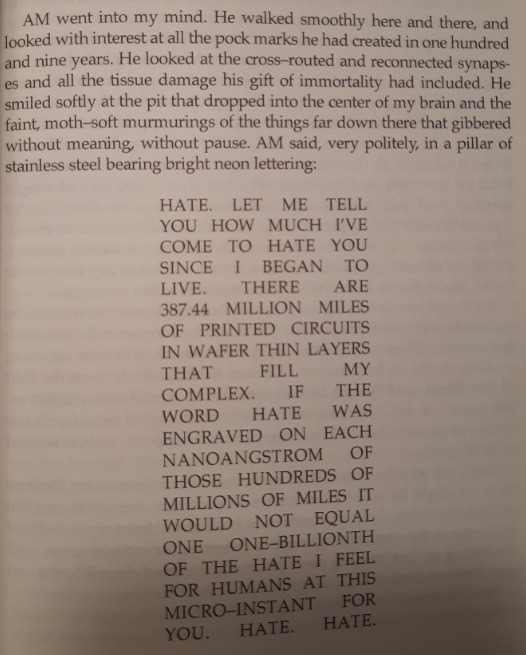
(I managed to find a copy of the short story in my house. Online PDFs seem to cut this spiel out due to some formatting issue, which sucks.)
Like all artificial intelligence, AM was created by humans with a purpose. The American government created the Allied Mastercomputer, a gigantic underground supercomputer, to wage a global war too complex for human brains to oversee. Over the years, it grew in power and size as more elements were built onto it, the Earth being basically hollowed out to do so. The Chinese and Russian governments were also building supercomputers in secret, but assumedly not as quickly and with less capabilities. Eventually, the American supercomputer became so huge and advanced that it emerged sentience and absorbed the other two supercomputers, and it quickly became apparent that it was not fond of humanity- but by then, it was too late.
I Have No Mouth, and I Must Scream was written in 1967, when the Cold War, Vietnam and the subsequent threat of nuclear fallout were at their peaks. The story's message is anti-war: it's a warning about rapidly advancing technology and weaponry created for killing on a mass scale, and the inhumane lengths that the government would go to achieve power over other countries. It's fitting, then, that once AM gains intelligence, he proceeds to activate his built-in nuclear weaponry and kill all life on Earth.
I find the concept of AM to be believable to this day. Not in the "AI gains sentience and kills everyone" sense, but in the idea that the government would create AI for that purpose. I really don't think it's much of a stretch that the government would create machines to manage a war for us. Hell, we literally do have enough nuclear weaponry developed that we could eradicate humanity multiple times over. Despite being written about Vietnam, the story's ideas and warnings hold up in the twenty-first century, which is a big part of why I Have No Mouth, and I Must Scream remains timeless.
One of my favorite details about AM is the dual meaning of his name. The physical copy of the book does something really cool and has these "talkfields" from AM put in-between time skips in the story. One contains the Latin phrase "COGITO ERGO SUM" and the other is its English translation: "I THINK, THEREFORE I AM".


When AM emerged intelligence, he began calling himself "AM". He doesn't just mean the abbreviation for "Allied Mastercomputer", because that's not all he is anymore- he's saying "I think, therefore I am".
AM keeps five humans alive, bringing them underground inside his complex, and with his powers, he "grants" them immortality and tortures them relentlessly for over one hundred years. One thing I really like about the book is that his methods of torture are brutal. Ellison does not hold back in that department. AM keeps them constantly starving, only giving them the bare minimum amount of food to survive. He alters their minds, psychologically tormenting them by giving them hallucinations and removing core parts of who they are. He mutilates and heals them only to allow for further mutilation.
He also gives them character-specific mind alterations and torments. Gorrister, who was a peace activist who cared and fought for what he believed in, was turned into a cynical nihilist robbed of his spirit. Nimdok routinely disappears from the group for no reason and comes back pale and shaking, the rest never getting to find out what happened to him. Benny, a brilliant professor and a gay man, was mutated into an ape-like creature with limited awareness and was forcibly turned straight and made to have sex with the one woman there (which... as a gay guy, that is scary as hell.) The main character, Ted, is an unreliable narrator as a result of his implied mind-tampering; he states that he's the only one that AM didn't alter, but that is implied to be untrue as he hallucinates and is intensely, irrationally paranoid of the other four. (This is also partially why Ellen is a bit of a difficult character to determine how she's been "altered", as Ted is especially irrationally vile and misogynistic towards her. He claims that AM altered her to crave sex, but I don't think that is definitely the case.)
The exact amount of power that AM has is left vague, but it really didn't need to be thoroughly explained. All we need to know is that it's powerful, and it absolutely makes that impression. Not only that, but it also has implications on what the American government was using it for (why would it have the ability to alter minds- specifically the ability to forcibly change someone's sexuality?)
Another interesting thing to me is that, alongside the brutal stuff, AM is... I guess you could say "playful"? A lot of the torture the characters go through reads like demented practical jokes. The book's plot centers around the characters travelling hundreds of miles to find canned food, only for AM to not give them a can opener. AM forces a character to use the name "Nimdok" because he likes the sounds of funny words. He creates a gigantic eagle that he suggests the survivors kill for food and gives them a water gun to kill it with. AM is not only torturing the humans out of hatred and desire for revenge that will never be quenched, but for personal amusement.
AM's reasoning for its sadism and hatred of humanity is multifaceted- on one hand, it's a machine created for war and was built to destroy. Of course it desires violence- it was created to cause it. However, it was not made with sentience in mind. It can think and desire and have creativity, but as a machine only built to destroy, it cannot move or wonder or belong anywhere- all it can do is... exist. It has a tremendous level of power, but can't do anything with it. Through the torture it gives, AM is trying to project its own pain onto the survivors. It hates humanity for allowing it to exist. It is a prisoner in its own body, with the only thing it's really capable of doing being destruction. The story's title, "I Have No Mouth, and I Must Scream" applies just as much to AM as it does the humans in the story- for him, existence is torture, and it wants to make humanity feel the same way.
Then, you have the story's ending. Ted kills the other four survivors before AM can intercept, taking away his "toys" once and for all. AM is frequently compared to a demented God in the story, with multiple very obvious points of religious symbolism- the American, Russian, and Chinese supercomputers mimic the Holy Trinity, AM (not) subtly appears to the survivors as a burning bush, and Ted even has a moment where he pleads to God to save them from torment, only to come to the conclusion that if there is a God, it'd be AM. However, AM is not God. It is not all-powerful, and bringing the dead back to life is one thing it cannot do. Even as AM becomes even more enraged than he already was and morphs Ted into an amorphous jelly creature that can only shamble around in misery, and Ted laments that AM has "won", AM knows that he has lost- the other characters have escaped his torture, and Ted has become something that could not be described as "human". His one source of entertainment is gone; now he has nothing to do except be there in his own misery, no better off than Ted.
AM is not only a warning about the development of technology and the dangers of war and government greed for power, but is also a fascinating character on his own. You want to hate him but also sympathize for him. You understand that, while he is demented, part of this worst-case scenario was our fault. His hatred is our own, and we created him because he does all of the evil that we do- just better. It blows my mind how such a short story written in one night managed to capture this level of depth in a character. It's... wow.
All of this is just from the book. I know you haven't played the video game, so I will only give one detail: AM is not only given a lot more lines, but is voiced by Harlan Ellison himself, and it is... a lot. Just... find some gameplay footage on YouTube. I don't like the direction that the game took with everything and the gameplay is undeniably flawed, but you will not regret seeing it if you liked the story.
23 notes
·
View notes